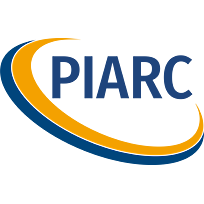

Applications, as part of asset management and within this manual, concern Asset Management Tools (AMT) designed to help the road organization apply an Asset Management Plan (AMP), and communication activities developed for augmenting implementation of asset management.
AMT refers to specifically designed software to apply a rational and efficient approach to asset management. The first AMT chapter describes in more detail what such a tool is, what are its inputs, and the basic requirements. The next two chapters specify what to consider when making the case for an AMT, and what is its structure.
Asset management tool should perform a number of main functions which are explained for organizations at a basic, at a proficient and for organizations at an advanced maturity level. The AMT will be sustainable only if a road organization is supported by a complete business plan that sets out the investment and is able to fund the activities required, as explained in the fourth AMT chapter.
Relevant information associated with asset management should be actively communicated through engagement with internal staff and external stakeholders in setting requirements, making decisions, and reporting performance. A strategy for how to communicate this information is explained in chapters about internal and external delivery of AMP, as well as indication on how to do it for organizations at different maturity levels.
An asset management tool (AMT), as described in the following chapters, is a professional software that is used by a road organization to apply a rational approach to asset management. Therefore, it does not refer neither to an organization nor to a set of procedures. This kind of software supports the organization with significant computation for data processing and storage, maintenance and investment strategies or scenarios, and graphical display.
The following chapters explain the benefits of an organization having implemented such a software into daily practice. They focus as well on making the case on an AMT and provide information on the AMT structure. This information is provided for organizations at a basic maturity level, at a proficient level and at an advanced level. This section ends with explaining business plan for acquiring an asset management tool.
An AMT is professional software that is used by a road organization to apply a rational and efficient approach to asset management. An AMT always has two types of inputs:
Data that describe the transportation asset, its components (pavements, bridges, engineering structures, equipment, etc.), its nature and characteristics (drawings, design, construction reports, etc.), its condition (strengths, distresses, etc.) and other attributes that apply to it (traffic, climate, etc.)
The rehabilitation, maintenance, and operation scenarios that are considered by the road organization, including assumptions about external factors (budget, traffic, climate change, etc.) and their decided rules
An AMT helps road organizations perform various analyses, run several simulations, test a number of management scenarios, and finally decide which strategies are the most appropriate to meet their objectives (Figure 15.1). Basically, the AMT should meet two requirements:
The structure of the AMT (Figure 4.1.1) should reflect the procedures of the asset management approach described in the previous chapters. Because these procedures are progressively completed from one maturity level to the next one, the AMT should be modular software that can be enhanced by new modules or expanded functions as the road organization progresses from one maturity level to the next.

An AMT should never force or limit in any way the choices or decisions made by the road organization. The AMT should help staff to consider all realistic options and strategies in managing assets in the short, medium and long terms.
Applying an asset management approach, particularly for lifecycle planning (see section 2.4), requires significant computation for data processing and storage, maintenance and investment strategies or scenarios, and graphical display. Such a computation-intensive approach is likely to be more applicable to organizations at the Proficient and Advanced maturity levels, which consider several (technical, economic, social, and environmental) requirements and apply a variety of mathematical and statistical approaches and Bayesian analysis and enable a heuristic approach to asset management. Such methods involve the simulation of a large number of complex scenarios, which may require significant computing power. However, even at the basic maturity level, a significant number of operations is required. Furthermore, at all levels of maturity the ability to display the results of the scenarios in clear and understandable route diagrams, tables, and maps is a crucial aspect of asset management that enables it to demonstrate benefits such as efficiency.
As a consequence, modern transportation asset management analysis requires computers capable of sophisticated computational analysis. Asset management tools have been in use for at least two decades that support this need. They are not only able to deal with a huge amount of data and analysis scenarios, but can also present the results in visual formats such as GIS.
Overall structure
An asset management tool supports the implementation of the asset management framework by performing the following main functions:
Each of these functions is developed to a greater or lesser extent depending on the maturity level of the organization implementing the asset management procedures, as described below.
Note that although data collection and processing is an important and difficult phase in road asset management, it is often considered as a separate task, either performed with specific devices by contractors (road condition indicators) or resulting from a careful review of an organization’s archives (road structure, maintenance works…). This is discussed in more detail in section 2.1 of this guide.
The main functions of an AMT for organizations at a basic maturity level are as follows:
Calculation of KPIs at a given time, which corresponds to the time when the data were collected (year n). At the basic maturity level, the technical KPIs are mainly structural and surface ratings.
Development of maintenance programs (type, priority, and ultimately a list of actions) and allocation of resources based on predefined strategies. Because no deterioration models are involved at this level, medium- and long-term performances and programs cannot be assessed. Accordingly, the outcome consists of an annual (year n+1), biannual (years n+1 and n+2), or at most triennial (years n+1, n+2, and n+3) program. This function is realized in three steps: identification, prioritization, and allocation of maintenance needs (to year 1, 2, or 3). The basic assumption made in this module is that the maintenance and rehabilitation needs defined on the basis of data collected at year n will remain adequate even if they are applied in years n+2 or n+3, which often is not fully satisfying.
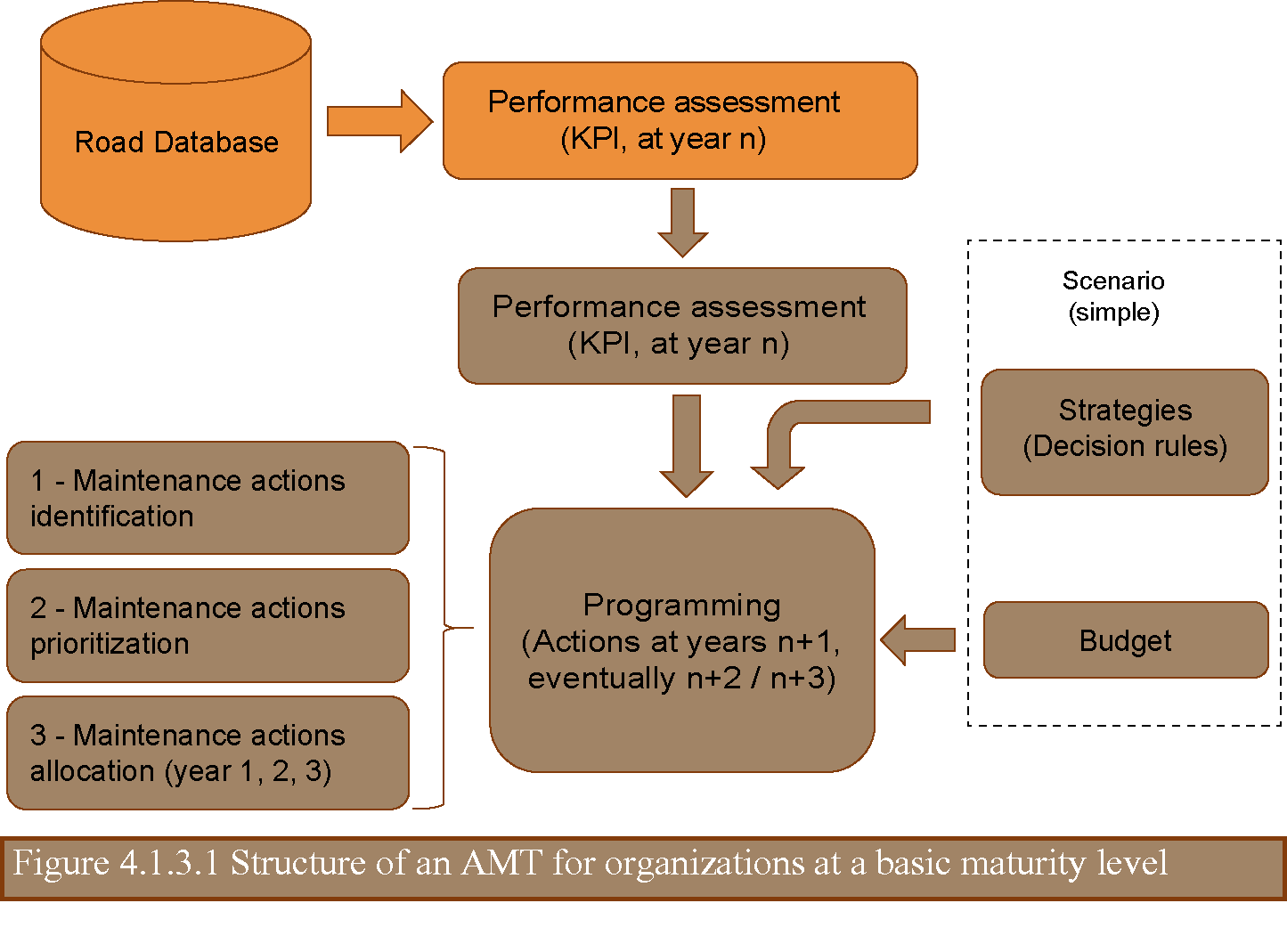
According to the approach developed in this guide, the AMT for organizations at a proficient maturity level should include greater functionality than that for organizations at the basic level. The greater functionality is as follows:
Deterioration models: Deterioration models are calculated and applied. These models mainly include distress evolution models and some physical characteristics evolution models (deflection, texture, skid resistance, etc.). With these models, the AMT can be used to simulate different scenarios in the medium and long terms. The set of condition indicator evolution models includes two types of models:
Natural evolution models (NEMs): These models quantify the variation of condition indicator values over time due to climate and traffic when no intervention is applied.
Intervention effect models (IEMs): The maintenance and rehabilitation interventions obviously have some effects on the condition indicators, which reflect the effects the interventions have on the asset. These effects are specified in the intervention effect models.Figure 4.1.3.2 illustrates such models.
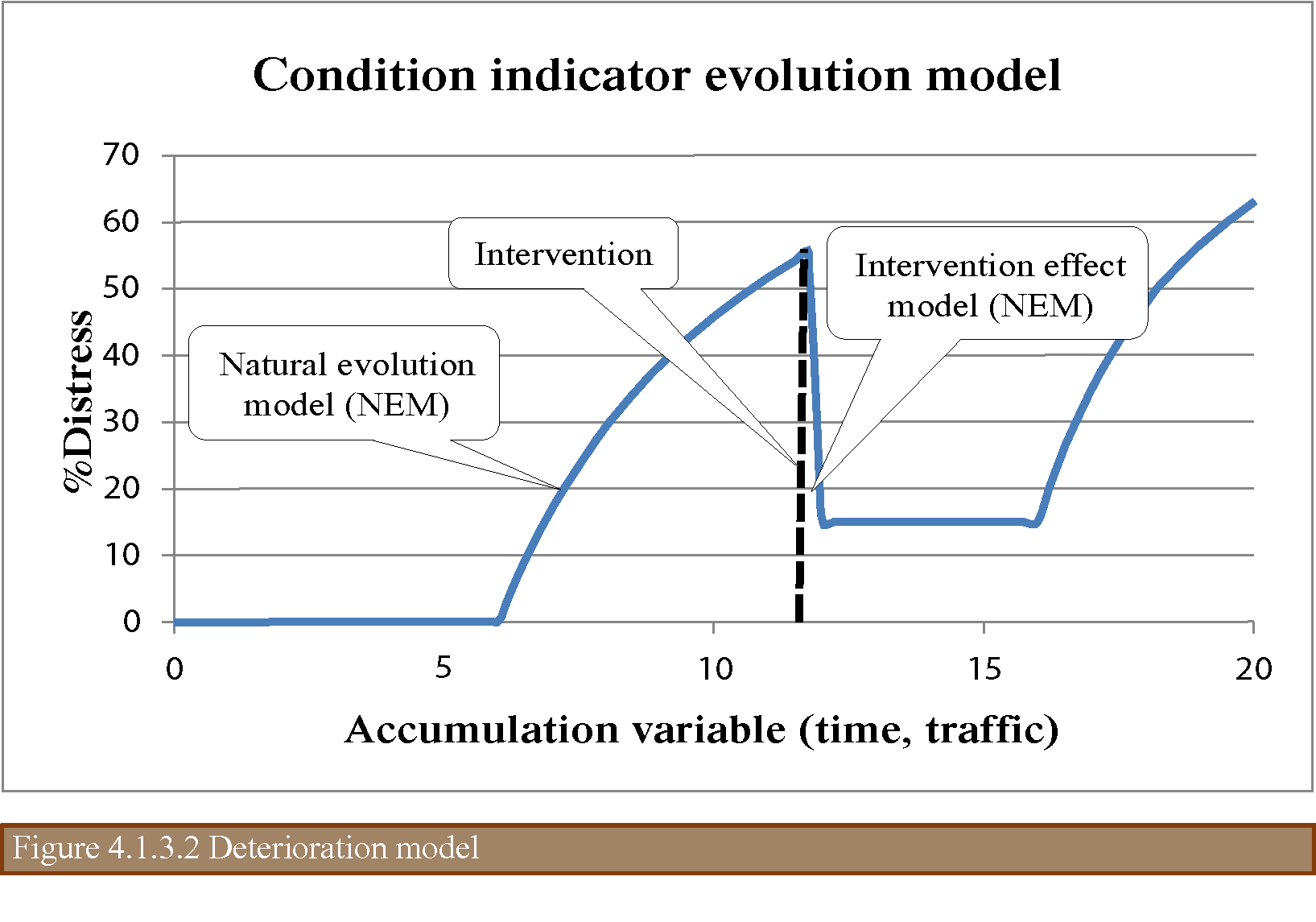
Performance assessment: The performance module is expanded to take into account more detailed data and deterioration models and calculate costs and benefits using socioeconomic and environmental KPIs. Including GRC and DRC in the calculation of asset values is one of the supplementary performance indicators. (Refer to section 3.3 of this guide.)
Note that a performance modeling module involves one or two sub-functions (Figure 4.1.3.3):
Minimally, application of condition indicator evolution models (NEM, IEM) to actual data in order to simulate the aging process of the network. This sub-function is necessary to perform medium- and long-term simulations.
Optionally, identification of these condition indicator evolution models from the data collected on the network during previous surveys and stored in the road database. Note that these models can be derived from external studies too, but not as well.

Figure 4.1.3.3 Structure of an AMT for organizations at a proeficient maturity level
Multi-annual maintenance programming: Given the condition of the network in a certain year, the asset management strategies, and the annual budget (which may vary over time), the module should be able to simulate different scenarios over the medium and long terms.
Cost-benefit analysis (CBA): Basically, CBA balances the total costs of maintenance to prevent asset deterioration (treatment costs, road organization costs, extra costs for work areas, costs of negative environmental impacts in the short term, etc.) and the total benefits produced by maintenance (medium- and long-term positive impacts on the economy, society, and the environment) in the same period. This balance has meaning only when calculated based on the lifecycle of the asset components. The lifecycle is the period between two major asset component reconstructions. Performing CBA implies that the previous AMT structure needs to be enlarged to take into account the various impacts of asset management. Different modules should be added to the structure, as shown in Figure 4.1.3.3.
Assessment of all costs caused by intervention on the asset, such as the direct works costs, the indirect work costs, the costs of traffic management during the interventions (detours, signs, etc.), the costs to the users during the intervention (extra delays and fuel consumption caused by congestion), etc. Specific models may be required to evaluate these costs, for instance the costs of congestion during the intervention, which depend on the traffic signature, or the costs of the reduction in flow capacity.
Assessment of all benefits resulting from intervention, such as reduced travel times, vehicle operating costs, traffic risk, etc. Again, specific models must be added to the structure illustrated in Figure 4.1.3.3 to perform these assessments.
Finally, the complete structure is shown in Figure 4.1.3.4.
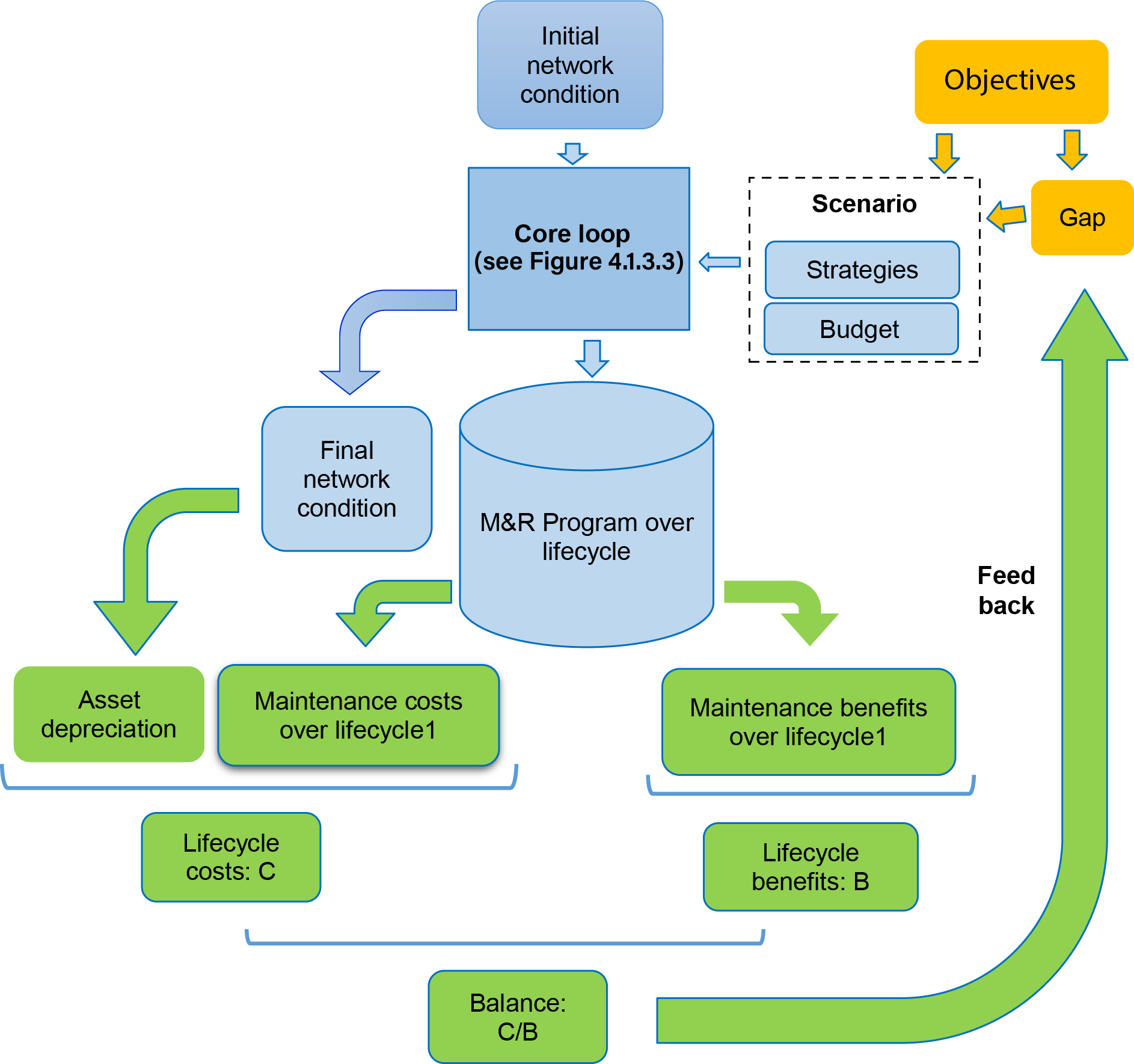
Figure 4.1.3.4 Complete structure of CBA
The result of the CBA is affected by a number of issues. There may be uncertainties, such as traffic demand and growth, that affect asset performance, particularly as a result of the climatic region. Accordingly, CBA cannot deliver exact and definitive answers. A risk analysis must therefore be conducted to quantify the reliability of these conclusions.
Risk analysis: Risk analysis does not need a specific or additional module. It is conducted by iterating the simulation through a number of scenarios according to the structure illustrated in Figure 4.1.3.3 with each scenario assigned a specific probability or distribution of probability (of traffic growth, budget reduction, occurrence of an environmental event, modification of regulations or laws, etc.). The realism of the risk considered in the analysis is decided by an experienced user. The results of the different runs are weighted by the probability of the simulated scenario occurring. The strategies that are finally fixed are those that realize the accepted risk for the road organization.
Financial plan: As with risk analysis, this function does not require a specific module. It is performed by well-organized and coordinated applications of the structure illustrated in Figure 4.1.3.3. Two sets of applications are required to build a rational and consistent financial plan:
Simulation of past strategies, in which the AMT is used to find the strategy that is consistent with the recent evolution of the network condition, given the external factors affecting the network (traffic variation, climate events, geologic events, etc.) and the budget.
Selection of future budget and strategies and, consequently, simulation of realistic scenarios, which will ultimately provide information on the best schema of budget allocation.
An AMT for organizations at this maturity level requires at least three additional functions:
Investment strategies: Beyond the maintenance policy, the most significant problem that any road organization deals with includes evaluating how much of the budget should be invested in the road to secure its value and services. Using the system illustrated in Figure 4.1.3.4 may be sufficient to answer this question. No additional software module is required to perform this function.
Asset management plan: Once the CBA and risk analysis are performed with the help of the system illustrated in Figure 4.1.3.4 the asset management plan can be finalized. No additional software module is required to perform this function.
Performance monitoring: Once the annual maintenance program has been carried out on the whole asset, the KPIs can be recalculated either from collecting new on-site data for the whole or a part of the network or from applying condition indicator evolution models. The Performance Modelling module is available to perform this updating of the overall assessment of the asset. No additional software module is required to perform this function.
Requirements for an AMT are summarized in table 4.1.3
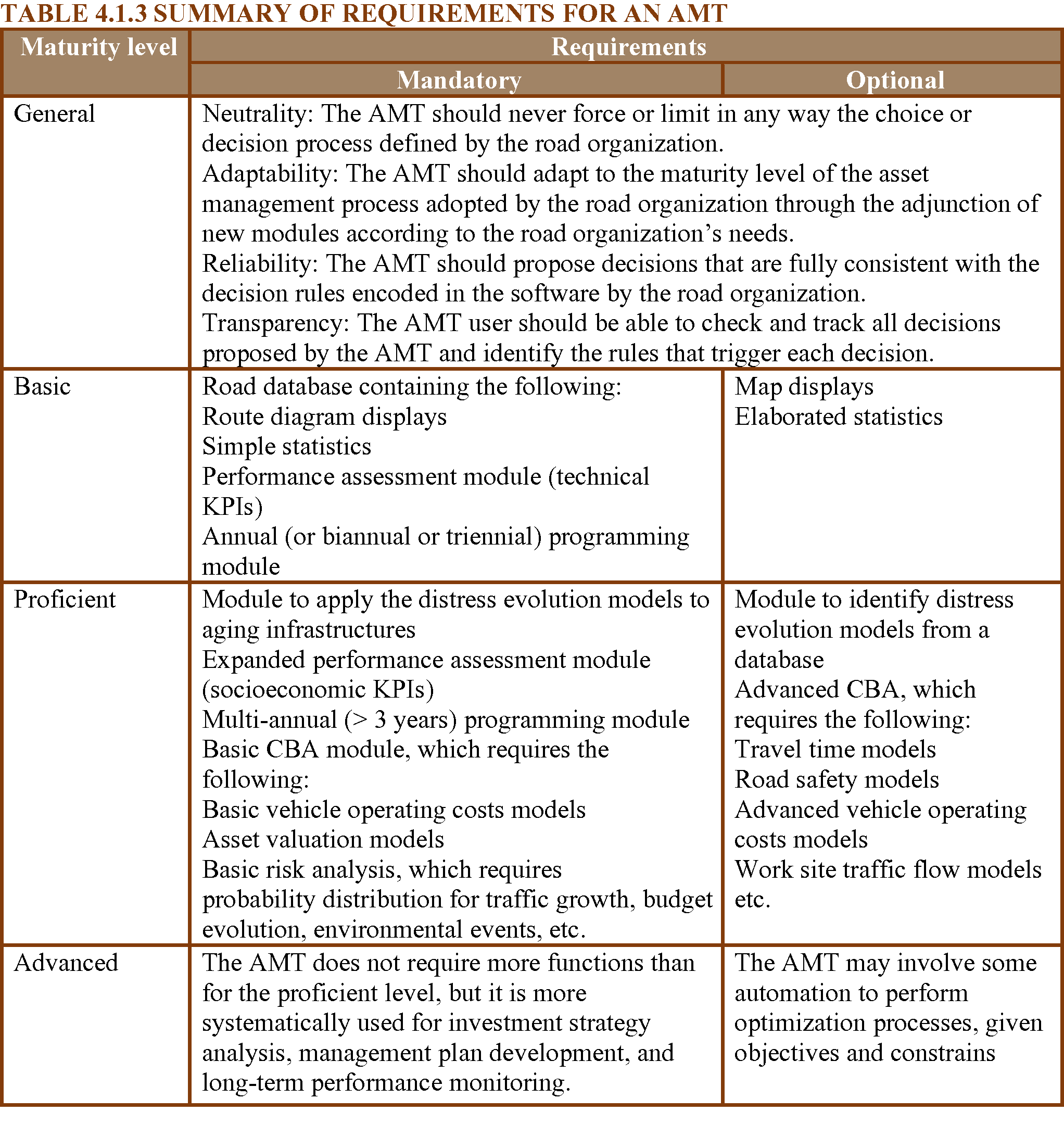
Note that the same AMT should be applicable for organizations at the basic to the advanced maturity level, which means that it should potentially meet all the requirements. However, the operating system needs only to meet the requirements applicable to the maturity level of the asset management process at a given time.
Buying an AMT may be expensive. Without up-to-date data or trained users, the AMT will be of no help for the road organization. Therefore, the implementation of an AMT in a road organization should be supported by a complete business plan that sets out the investment required and the benefits. Importantly, the organization must also be able to fund a data collection program over the lifecycle of the system. Without this, the AMT will not be sustainable.
The system should consist of a road database plus a set of data interpretation modules, as described above. The cost of initial licenses, generally a lump sum, must be funded. Sometimes the database display functions are below the level specified by the road organization. In that case, the road organization must complete the database with GIS, and the cost of the license(s) must be added to the lump sum. Moreover, in most cases the proposed software includes a maintenance option, which implies a recurrent expense that has to be funded as well.
The system is run using inventory and condition data. These data must be sufficient, reliable, and up to date. A significant amount of work is required to initialize the process (mainly gathering inventory data) and collect condition data recurrently (possibly annually) on site. For this periodic collection, different schemas exist. For instance, some road organizations collect data on the whole network every “n” years, while others collect data on a part (1/N) of their network every year. Some road organizations employ their own staff to collect data, while some others contract the data surveys to specialized companies. In all cases, the implementation of an AMT requires an initial investment in the collection of inventory and condition data, plus a recurrent budget for collecting updated data. This investment must be considered in the business plan.
The most important effort when installing an AMT involves the configuration of the analysis modules. From this point of view, each AMT is different. The context (climate, traffic, road construction, road maintenance) varies from one road organization to the next. Thus, the professional expertise, experience, and even culture are different from one country to the next. The configuration of the AMT involves collecting the local expertise, experience, and culture to formalize these factors and incorporate them into the software. This may require a significant amount of time, but the success of the installation and the later application of the system strongly depend on the quality of this configuration. The configuration phase can gradually turn into a training phase for the future users of the system. Subsequently and periodically, some additional training can be proposed to upgrade the AMT users’ skills.
Therefore, the decision to implement an AMT must always be supported by the production of a business plan that will identify the sources of the initial and recurrent funding. Table 4.1.4 illustrates the relative weight of the expenses.
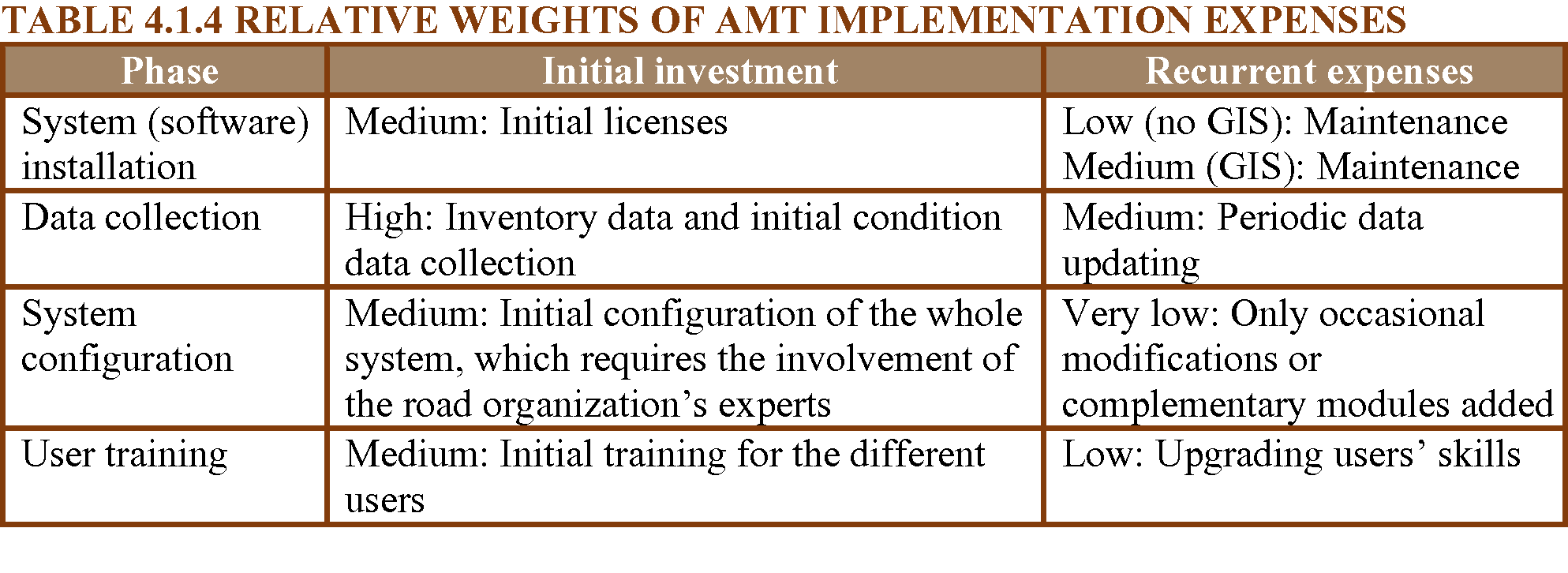
- Successful Practices in GIS-Based Asset Management, NCHRP Report Issue Number: 800, Publisher: Transportation Research Board ISSN: 0077-5614, http://www.trb.org/Main/Blurbs/172204.aspx;
- AASHTO Transportation Asset Management Guide—A Focus on Implementation, American Association and Transportation Official, June 2013, http://www.fhwa.dot.gov/asset/pubs/hif13047.pdf
The following case studies are presented in this chapter:
Case study 1: Successful implementation of a road assets management tool for the federal roads of United Arab Emirates
Case study 2: Asset management in Jiangsu province, China
AHMEDABDALLA AL HAMMADI, Ministry of Infrastructure Development, United Arab Emirates, Northern Emirates
In 2013 the Roads Department of the Ministry of Public Works of UAE (currently Ministry of Infrastructure Development, MoID), started the corresponding tasks for the project “Preparation and Operation of Pavement and Asset Management System”, whose object was the implementation of a methodology along with a management system, for the maintenance of the network of roads to its charge. The initial project was carried out from 2012 to 2016, and currently the second phase (2017 – 2019) is under development by the same company (RAUROS), due to the success obtained during the first one.
The projects include different tasks within the road asset management field, related to: condition survey data collection using high performance equipment, pavement condition analysis, maintenance plan analysis, road asset management system (RAMS) implementation and customization, bridges and slopes inventory, app development for routine works control, analysis of new maintenance solutions adapted to UAE road network characteristics and a full time consultancy service in UAE Ministry of Infrastructure Development facilities.
Below is described the work performed during these contracts, having received the first contract the 2015 Global Road Achievement Award in Asset Preservation & Maintenance Management, awarded by International Road Federation during Congress celebrated in Istanbul (Turkey) held in 2015.
The successful of this work is based on the implementation of a preventive system in UAE Ministry of Infrastructure Development procedures adapting it to UAE road network characteristics, the full time consultancy service, and the implementation of a modern, powerful and useful system that allows technicians and manager to make easier and faster decisions, based on technical and economic parameters for achieving an optimum maintenance of the road network.
The network of roads of the Ministry includes freeways, highways and conventional roads, being most of them spread over the north of the country, with an approximate length of 1,300 kilometers of carriageway, equivalent to 2800 kilometers of lane.
In order to schedule a correct maintenance planning, it is crucial to know the road assets that form part of the network of roads. Therefore, the first tasks have consisted of taking a full inventory.
For this purpose, specialized designed equipment was used. Such equipment can take images and other measurements while driving at to more than 70 km/h.
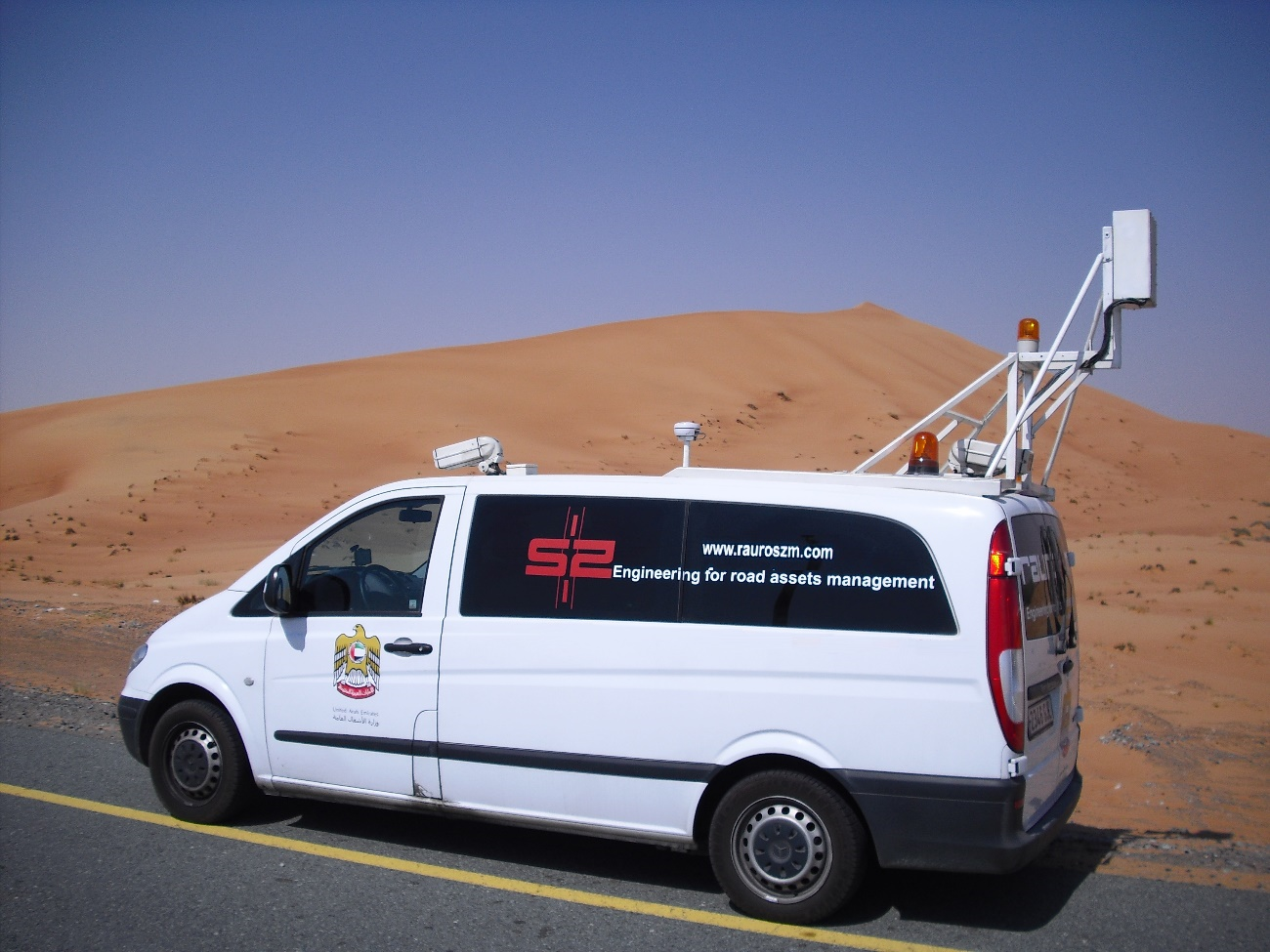
All the collected information allows to know the location and typology of the road assets that need maintenance: signage, highlights, guardrails… This inventory allows, to the conservation staff, to drive a correct control of the routine maintenance and schedule all type of inspections.
It is a fact that pavements constitute 80% of the investment required for the maintenance of the network. Therefore, it is necessary to know their condition. For this reason, different tests are performed by using high performance equipment.
Functional and structural characteristics were evaluated. The functional characteristics are tied to the diving surface of the pavements. Four functional parameters are annually measured in the roads of UAE:
Such measurements are obtained through the measure of the transversal profile, by using specific equipment that has several laser devices lined-up. From the transversal profile, the depth of each rut can be calculated.
Besides, there exist some structural characteristics.
The knowledge of the traffic of each one of the roads and its evolution is another key factor. For this purpose, several counting stations to determine the traffic density are being installed in strategic spots within the network. A total of 27 fixed stations are being installed, and 70 measurements of temporary traffic density are being taken. The counting stations count the number of vehicles and classify the data regarding the vehicle typology; they also take measure of its speed. Another essential parameter that needs to be determined is the weight of the vehicles. For this purpose, 5 stations of dynamic weighing (Weight in Motion) are being installed. These devices take measures of the load per axle, information which is absolutely necessary for adjusting the calculations when dimensioning reinforcements in the pavements.
Additionally, a highly detailed inventory of all the bridges, slopes, culverts and camel crossings is being performed. At the same time, basic inspections of each asset are being made. The inventory comprises the geographic location of the structure and the identification of each forming element (typology and material). The geometrical dimensions of each bridge is being also determined. The routine inspection consists of a primary visual identification of possible damages or pathologies that can cause failures in the structure, from the functionality or durability point of view.
Lastly, but no less important, some testing/coring are being made within the whole road in order to perfectly know the cross section of each road, so proper pavement analysis can be made, specially where new materials have been used for rehabilitation purposes.
Once data taking is concluded, in order to manage and take benefit of the huge amount of information collected, it is entirely essential to rely on a proper asset management system.
For this purpose, the choice made by the MoID was ICARO, a comprehensive Road Asset Management System (RAMS) used internationally and which first version was developed more than 15 years ago, made out of the collaborative work of a highly qualified team formed by computing and civil engineers, permanently focused on the needs of technicians and managers of public administrations and highways operating companies of all over the world.
The implantation of ICARO has allowed the MoID to take advantage – by using a single and powerful tool – of all the necessary data to carry out the full management of the road heritage. Such essential information has been provided by means of photographic, cartographic and numerical way, all under total coordination.
Technicians of certain areas within the General Direction of Roads can now study the data aforementioned in a simple way. Additionally, the data can contribute to provide information about road safety (crashes, risk index, etc..), as well as to control the routine maintenance tasks. Such extra information is extremely valuable for any administration of a network of roads.
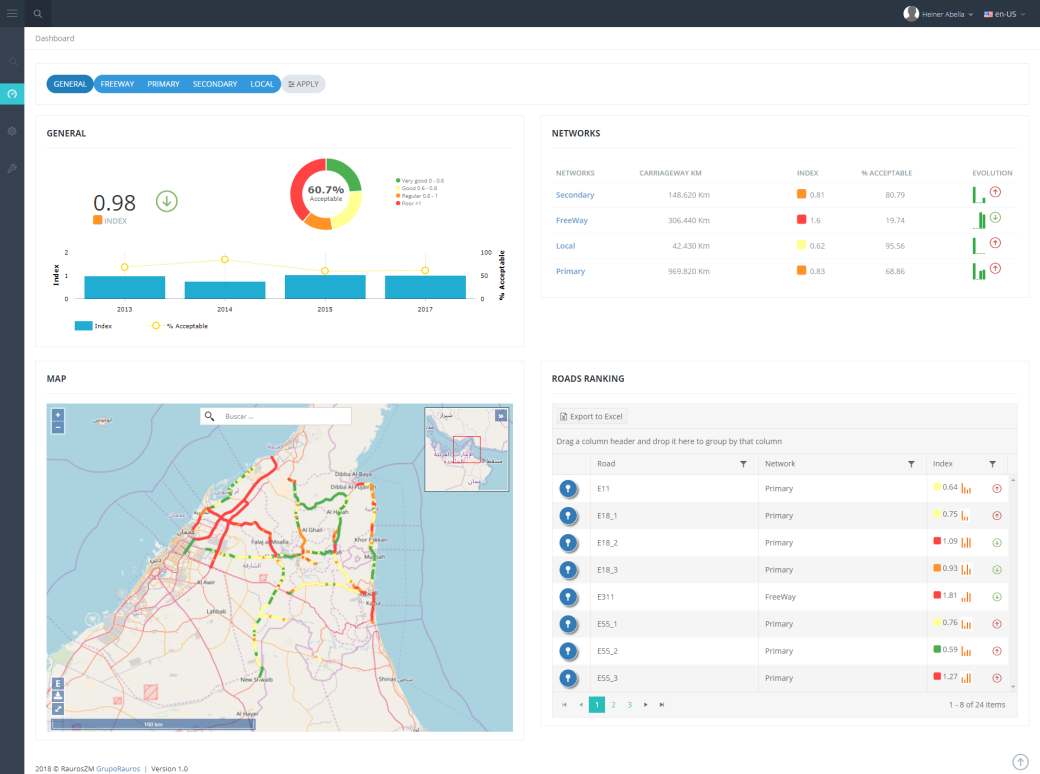
To carry out a preventive management is necessary to have a RAMS capable of storing and exploiting a large number of aspects:
In addition to the RAMS, it has been developed an app for the use of mobile devices which allows for georeferential data collection on-site to be later synchronized with the central system. The application has been designed to automatically place itself according to the position the GPS signal receives and to display the inventory asset existing in the system at that kilometric point. It automatically selects the corresponding road and stretch. The application allows reviewing the existent assets, to register the characteristics of them using their own files or to add new inventory assets.
In summary, the MoID can rely on an expert management system that allows:
Definitely, to increase the service standard offered to the users and to decrease its costs.
Knowing the possibilities of investment in the maintenance, determining the quality degree that can be achieved with such investments and defining suitable quality thresholds, the best preventive maintenance system can be attained. For this purpose, it is always necessary to reach the balance between the aim to fulfill and the investment to make. ÍCARO system provides the Ministry with a technical support that clearly justify when, where and how much it is necessary to invest in the maintenance.
This software has been installed in the Ministry offices, and not only the staff located in the Ministry main offices, but also the personnel that works in field, has full access to the system through the app.
All these tasks are being managed by a consultant company, and directed by the Ministry of Infrastructure Development staff,
It is known that one of the indicators of the level of development of a region is, without doubt, the state of its network of roads and roads in the case of a city.
Developed countries apply this preventive management model from the start-up.
At the same time, the regions that are still developing are incorporated into this model as soon as their economic capacity allows them to deal with non-basic aspects.
The preventive management of a network can only be carried out once a certain level of quality has been reached. Before reaching that level, the systems can only help to prioritize the actions. Later, the real preventive management will begin.
The main objective of this management method is to achieve a high degree of commitment to citizens, ensuring that investments will serve to achieve the best maintenance. In order to fulfill it, it is necessary to:
All this, for reaching a balance between the objective to be met and the investment to be made.
ICARO RAMS implemented and described in this case study is simple and powerful, developed by RAUROS for more than 15 years, and implemented in multiple administrations around the world, both private and public.
YULI PAN & JUNZHE WANG, National Engineering Research Center of Road Maintenance Technologies, PR China
This case study describes the annual based asset management carried out by Jiangsu Provincial Highway Administration Bureau for their trunk highways since 2008, as plotted in Figure 4.1.6.3, its scale increases 1.7 times within a period of 10 years.
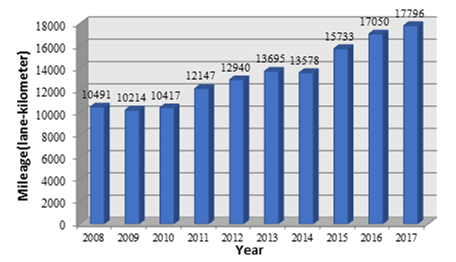
Figure 4.1.6.3: Scale of the Asset Management of Jiangsu Province
The main purpose of the annual application of asset management in Jiangsu province is to enhance the highway network management skills by using modern asset management equipment and systems, including high-speed highway condition monitoring vehicles, database and decision-making systems (L, Gao and X, Zhang. 2017).
Through the implementation of this asset management program, the Highway Administration Bureau is benefited in several ways:
The annual based asset management is conducted stage by stage as follows:data collection → distress auto-recognition → maintenance analysis → planning, scheduling and presentation.
Data Collection
Figure 4.1.6.4 is one of the three high-speed highway condition monitoring vehicles (CiCS: China's highway information Collection System) employed in Jiangsu's trunk highway investigations. The CiCS vehicle is able to collect highway conditions including cracking, pot hole, longitudinal profiles, transverse profiles, pavement texture, grade, curvature, and slope, front images, and GPS etc. information all together with traffic stream speeds.
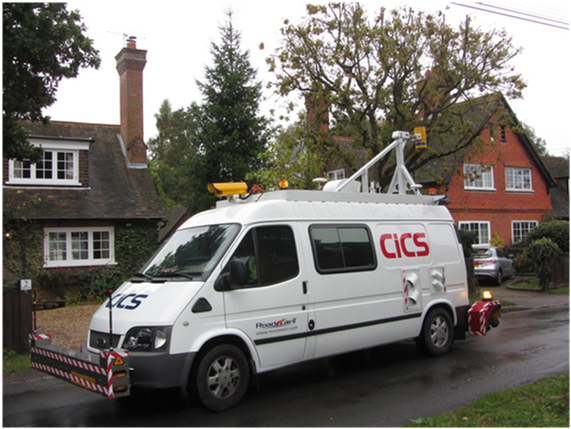
Figure 4.1.6.4: CiCS Data Collection
Distress Auto-recognition
In this stage, highway conditions including pavement distress, pot hole, road signs are automatically recognized by a AI based software CiAS (China's Highway information Auto-recognition System) as seen in Figure 4.1.6.5.
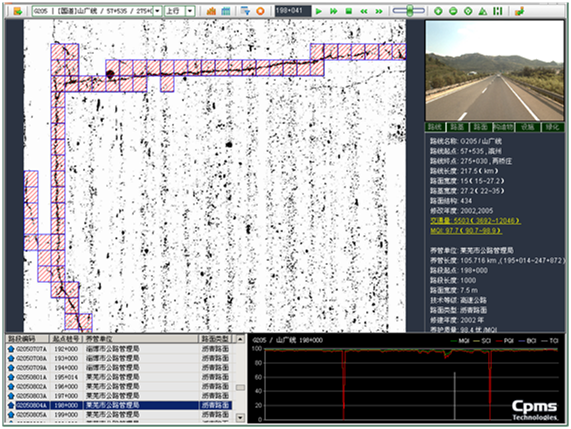
With the obtained highway condition data, highway condition evaluations can be conducted according to the Highway Performance Assessment Standard (MOT PRC, 2007), and further maintenance analysis can be performed by using the CRMS system (China's Road asset Management System), including performance prediction, road user cost estimation, maintenance needs analysis, budget assignment, project optimization, planning and scheduling as shown in Figure 4.1.6.6.
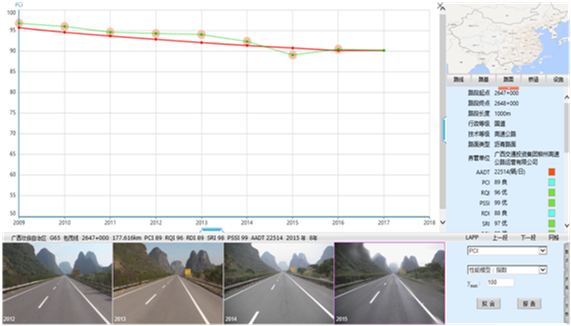
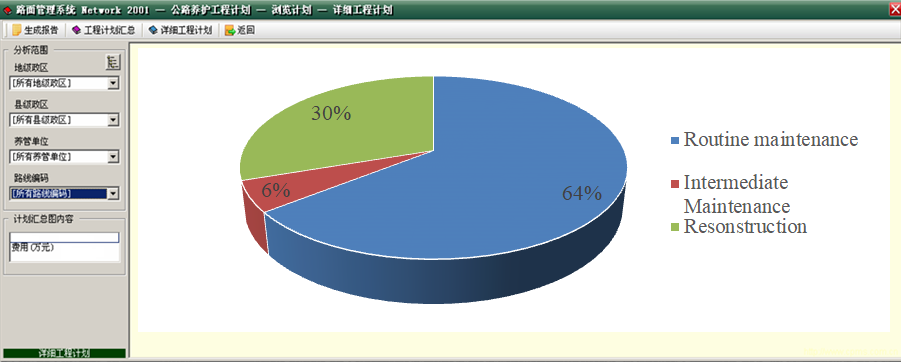
Planning, Scheduling and Presentation
The CRMS provides two sorts of platforms as shown in Figure 4.1.6.7 (PC Platform) and Figure 4.1.6.8 (Mobile phone platform). The two platforms enable the Highway Bureaus to conduct and present their highway network managing plans and maintenance schedules and mapping the results on the platforms, that automatically likes the visual information (maps, pavement images, front view images) with all other information such as inventory, maintenance history, current conditions, future performance and analysis results.
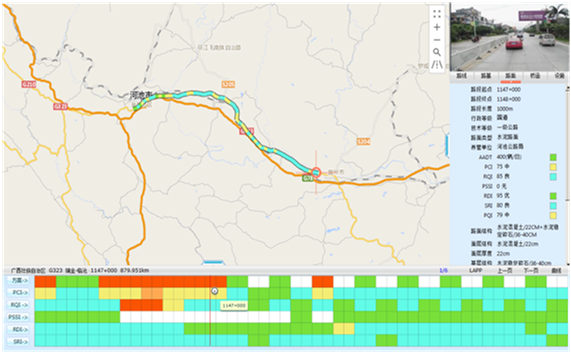
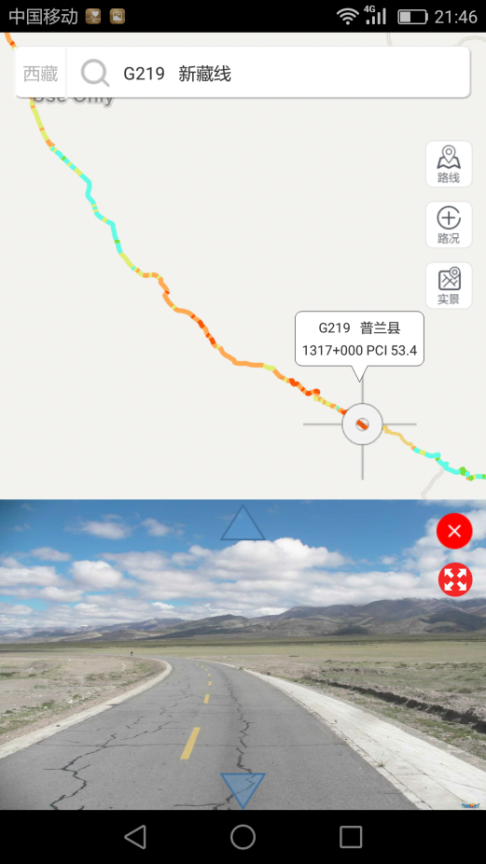
The annual based asset management conducted in Jiangsu Province has significantly changed the traditional manner of highway asset management. With the modern technologies, the Jiangsu Provincial Highway Bureau (and its district level Highway Bureaus) is able to manage their highway asset with a more cost-effective way, through the procedure of data collection, distress auto-recognition, whole life cycle cost-based maintenance analysis, and planning and scheduling.
Ministry of Transport, PRC.2017. Annual report of national highway maintenance statistics. Beijing.
L, Gao and X, Zhang. 2017. Construction of scientific decision-making system for trunk highway in Jiangsu Province. Maintenance Engineering (145) PP. 44-48.
Ministry of Transport, PRC. 2007. Highway Performance Assessment Standards. China Communications Press. Beijing.
As an organization implements an asset management program, it should develop a communication plan. Augmenting the implementation of asset management with a communication plan can be helpful. Because of the large number of staff and functions that need to be coordinated, communications is essential internally. It is important for staff to understand what is taking place and their roles. Communication with external stakeholders and customers is equally important to convey what is being done, why it is being done, what is planned, and what are the key expectations with regard to level of service, performance targets, and funding scenarios.
Relevant information associated with asset management should be actively communicated through engagement with internal staff and external stakeholders in setting requirements, making decisions, and reporting performance. It is important to discuss and develop a strategy for how this information is communicated, e.g. with pre-prepared material such as videos or annual reports (FHWA, 2017; Swedish Transport Administration, 2016).
Asset management requires high-level and abstract attributes such as long-term vision and strategic goals. It involves detailed information such as the fields of data used for asset inventory and condition databases. To carry out the AMP, road organization employees (Iowa DOT, 2014, Transport asset management) and vendors must understand not only the long-term vision but also the detailed technical requirements of providing the data, conducting the asset assessments, programming the correct projects, and conducting the proper maintenance to achieve the long-term vision. A communication plan and effort can serve an important coordination function. This effort can provide motivation, note accomplishments, maintain momentum, and enhance the breadth, depth, and effectiveness of implementation in the organization.
The personal involvement of the leader can be an important component of the communication effort. Effective communication includes both formal and informal communication, with the informal communication often being the most effective since information is transferred and conveyed in a more freely and quicker way. When employees see the personal engagement of the leader in the asset management implementation effort, it reinforces the importance of and communicates the commitment of the leadership to asset management. It is essential that staff understand that they have a role and what their respective responsibilities are with regard to moving asset management efforts forward.
An external communication plan helps keep the external stakeholders informed, involved (Iowa DOT, 2014, Thinking differently), and supportive of the agency’s asset management effort. Communicating the progress made and the next steps being pursued in the implementation of asset management also shows accountability and adds credibility to the agency’s effort. It is important to have performance measures and targets that are understood.
Engaging with stakeholders to understand their needs and expectations provides the information needed to determine and review the service provided by road infrastructure assets and hence the asset management activities. The road network is often of significant interest to the public and the media. This interest is likely to continue with robust public expectations for how the network should function.
The levels of service that underpin the AMP must be based upon a good understanding of stakeholder and customer priorities and expectations (Austroads, 2009), and they are essential to the success of the AMP. The AMP is an effective mechanism to communicate levels of standards, performance targets, funding scenarios, and outcomes and to manage customer expectations.
An AMP is an important tool in addressing the trend towards transparency, which results in the increased availability of a wide range of information in the public domain. Organizations should provide clarity and transparency in how they make decisions in the identification, assessment, programming, and delivery of asset management activities, including maintenance works, and should clearly explain how such decisions were affected by public input or how these decisions will impact the public.
Providing good quality information to stakeholders on what can be expected from the asset management approach is an important aspect of service to the public. A clear and effective approach to communications within the asset management framework can be an excellent means of providing information and responding to challenges related to programs of maintenance works and value for money (FHWA, 2015). Effective communications also assist with the often high volume of public requests, reports from multiple sources, and media interest in road maintenance. The potholes review undertaken by the Department for Transport in England (HMEP, 2012) and Scotland’s National Road Maintenance Review (Transport Scotland, n.d.) recognize the importance of communications and make recommendations in this regard.
For organizations just initiating an asset management framework, it is common to operate in silos. Efforts need to be in place to establish clear agency goals as well as an asset management group that focuses on how to implement asset management in the organization.
Organizations that are more mature in implementing asset management address one of the key challenges: the introduction of a holistic approach to the delivery of services that removes organizational silos and promotes integration of processes, information, and systems. Introducing this holistic approach leads to a more efficient way of working by removing duplicate and redundant processes and by service-wide decision-making, but it also requires changes to the working culture to engender greater cooperation and flexibility among staff.
To ensure the successful adoption of asset management, the asset management group needs to be proactive in informing other staff and also involve others in the process. The asset management group is established to produce, manage, or steer the development of the AMP and to steer or manage implementation.
The leader of the group conveys the goals and the importance of implementing an asset management framework in the organization. Senior management needs to be involved at key points, needs to fully support the process, and needs to be keen to see the benefits that will be realized.
A program of training and education in good asset management practices needs to be established. This includes allowing staff to be available for training and education in asset and infrastructure management as part of their professional development, and seminars to inform a wider range of participants, including interested external parties, about asset management and about the organization’s progress and intentions.
It is intended that the AMP, as it develops, will be a key reference document to all of those involved in management of service delivery on the road network. The AMP needs to be available internally and externally.
Asset management enables the following (as illustrated conceptually in Figure 4.2.3):

FHWA. 2017. Asset Management. Videos. Available from: https://www.fhwa.dot.gov/asset/video/index.cfm [7 February 2017].
The Swedish Transport Administration, 2016.Annual Report 2015. Available from: https://trafikverket.ineko.se/Files/en-US/17478/Ineko.Product.RelatedFiles/2016_054_trafikverkets_arsredovisning_2016_engelsk.pdf [7 February 2017].
Iowa DOT. 2014. Transport asset management – how does it impact employees? Available from: http://www.transportationmatters.iowadot.gov/2014/11/iowa-dot-transportation-asset-management-how-does-it-impact-employees.html [7 February 2017].
Iowa DOT. 2014. Thinking differently - transportation asset management ramps up at Iowa DOT. Available from: http://www.transportationmatters.iowadot.gov/2014/11/thinking-differently-transportation-asset-management-ramps-up-at-iowa-dot.html [7 February 2017].
Austroads. 2009. Guide to Asset Management Part 2: Community and Stakeholder Requirements.
FHWA. 2015. Public Involvement Techniques for Transportation Decision-Making. Available from: https://www.fhwa.dot.gov/planning/public_involvement/publications/techniques/chapter00.cfm [25 February 2017].
HMEP Highways Maintenance Efficiency Programme. 2012. Prevention and a better cure. Potholes review. UK: Department of Transport, 72 p. Available from: www.gov.uk/government/uploads/system/uploads/attachment_data/file/3995/pothole-review.pdf [7 February 2017].
Transport Scotland. National Roads Maintenance Review.UK: Transport Scotland. Available from: www.transportscotland.gov.uk/road/maintenance/national-roads-maintenance-review [7 February 2017].
THOMAS LINDER, Bavarian State Ministry for Housing, Building and Transport, Germany
Communication is one of the key elements to achieve an appropriate funding for road maintenance. But communication in this context is not only communication between road engineers. It is essential that a proper communication is carried out towards the decision makers, finally it will be the Minister of Transport, the Minister of Finance, the Government and the Parliament or members thereof.
The goal is to communicate in a way that is easily understood by non-professionals in the field of road engineering.
The benefit will be a better understanding of matters in the context of road maintenance management or more comprehensive in terms of road asset management.
In a 7-step-process it is shown, how better communication on road asset management can result in a better funding of road maintenance:
The key is to explain in simple words what you are doing. Simplify the consequences of different strategies. Involve your boss up to the Minister as the top decision maker.
LINDER, T.: How can we communicate better on road asset management. Presentation during the PPRS2018 (Pavement Preservation and Recycling Summit) conference, Nice, France, March 2018.
Bavarian State Ministry of the Interior, for Building and Transport: Maintenance management for Bavarian Roads, Munich, Germany, August 2011 http://www.bauministerium.bayern.de/assets/stmi/vum/strasse/bauunderhalt/42_maintenance_management_201108.pdf
The present section of the manual deals with the most relevant aspects of digitalization and information management from the point of view of the owner and operator of the road infrastructure. It is strictly oriented to the ISO 19650 standard while addressing the context of the entire road network. For the aspects of BIM and digitalization at the project level, please refer to the PIARC report "BIM and Digitalization" (PIARC 2023).
In recent years, digitalization in the construction industry has been accompanied by the term “BIM” (Building Information Modeling). Most practitioners associate BIM with the planning, design, and construction of vertical infrastructure and occasionally with tunnels or bridges. More recently, BIM methods are being applied to horizontal infrastructure.
The term “horizontal infrastructure” is used to describe the entire infrastructure networks, such as roads, railroads, water supply and sewage, telecom, diverse pipelines, etc., under the responsibility of one operator or owner. Horizontal infrastructure consists of linear infrastructure objects, such as road sections, and objects of other types, such as bridges, parking, toll stations or road equipment facilities. The subject of the operational phase of asset management is usually the entire horizontal infrastructure.
The implementations of BIM to date have focused on buildings and, in the road sector, on engineering structures such as bridges, tunnels, complex traffic intersections and sometimes on single linear infrastructures such road sections. At the same time, there are still very few solutions that address overall horizontal infrastructures, such as road networks. The horizontal infrastructures have so far only been accompanied by BIM processes during the planning or construction of their single components. This limitation of BIM to specific design and construction projects ignores the fact that, from the perspective of the operator of the horizontal infrastructure, the entire network, e.g. the national or regional road network, is often the subject of consideration and operational activity.
Such tasks as prediction of maintenance demand in order to achieve specific quality goals, preparation of maintenance programs, or network-related resilience analyses can only be performed successfully if certain information is only available across the entire network. This information must be available at the appropriate quality from the operator's perspective in terms of accuracy, completeness, and timeliness to support its tasks. In the road sector, such data primarily includes as-built data, condition data and traffic data. They are managed in the road information databases maintained by the operators for a particular road network.
Recent experience has demonstrated that the implementation of BIM processes can contribute to an increase in the efficiency of the planning, designing and construction of all transportation infrastructures. Time and cost discipline increases and the risks for owners, designers, constructors and suppliers are reduced.
The use of BIM in the transportation sector is becoming more mature and standards and best practice procedures have been developed, partly thanks to considerable government funding projects, and the software companies providing easy to use tools and applications. The experience gained using BIM is now being presented and exchanged at international meetings, conferences and through non-profit organizations such as buildingSMART or National Institute of Building Sciences (NIBS). PIARC has also contributed to the dissemination of BIM techniques for the road sector. In the report "BIM and Digitalization" (PIARC 2023), the fundamental rules for the application of BIM for infrastructure projects were presented through the publication of BIM case studies.
Owners and operators of horizontal infrastructure, such as runways, roads or railroads, also benefit from the adoption of BIM systems. Typically, these include local and central governments as well as private or public operators of infrastructure systems. The current focus of BIM is at the design and construction phase, and it does not sufficiently support the management and operation needs of transportation infrastructure on the network level. This shortcoming of BIM is now increasingly being addressed in various publications
In contrast to planning and construction companies that focus on individual projects, the manager of horizontal infrastructure is responsible for the ongoing management of an entire infrastructure system, or in many cases, the entire infrastructure portfolio. This typically includes inventory, construction and maintenance history data, asset condition, past, present and future traffic information etc. They all contribute to the Asset Information Model of the infrastructure portfolio. The requirements for the Asset Information Model must be defined in such a way that all operational obligations to keep the certain level of service are met in a sustainable manner. In addition to the direct operational tasks, the measures for asset maintenance and upgrading should also be planned and implemented. Maintenance and renewal decisions requires the consideration of needs of the entire network.
The specification of the requirements for the Asset Information Model, i.e. the data of the entire asset system or asset portfolio, is one of the relevant decisions to be made by the owner or operator of an infrastructure network. The requirements for the Asset Information Model are thus always a compromise between the desired high level of detail (high data quality) and ensuring that all data is available in the required completeness and timeliness. To ensure this in a sustainable way, the model must be aligned with the maturity of the organization and the goals of the infrastructure owner.
In recent years, BIM has moved forward to support the operational phase of asset management. The ISO 19650:2018 (ISO 2018) standard plays a key role in this context, positioning BIM in the direct environment of Asset Management in accordance with ISO 55000:2014 (ISO, 2014). Both standards are primarily focused on asset managers. ISO 55000 is considered a relevant guide for the present Road Asset Management Manual of PIARC. The requirements for information models, in the operational phase (Asset Information Models), and in the project phase (Project Information Models) in the ISO 19650 (ISO, 2018) standard are formulated in such a way that they can also be applied to Road Asset Management and to other horizontal infrastructure. This provides favourable opportunities for a broader digitalization that extends to the entire network and not only to the individual projects.
The present section of the manual deals with the most relevant aspects of digitalization and information management from the point of view of the owner and operator of the road infrastructure. It is strictly oriented to the ISO 19650 standard while addressing the context of the entire road network. For the aspects of BIM and digitalization at the project level, please refer to the above-mentioned PIARC report (PIARC, 2023).
BIM was originally associated with planning, design and later with the construction. The focus was on the interests of the designer and the construction companies or, more generally, the service providers or contractors. This is beginning to change, and the latest developments within BIM are focusing on the owner and operator of the asset.
The construction industry has been suffering from very low productivity for several decades. It deviates sharply from the efficiency of the economy as a whole in almost all countries, and the gap is gradually widening. This can be clearly confirmed by statistical data, i.e. (NBS, 2019). Most experts explain this low productivity by the backlog in digitalization in the construction industry. The level of digitalization in the construction industry is indeed dramatically low worldwide. The term digitalization is used hereafter as a change of process to incorporate digital technologies unlike digitization which describes the pure analogue-to-digital conversion of existing data and documents.
The vast majority of professionals in the construction industry consider BIM as a synonym for modern planning and design techniques, supported by the CAD (Computer-Aided Design) software, which make it possible to create a virtual construction object that acts as a kind of digital twin of the designed real object. Thanks to the use of modern 3D techniques, it is possible not only to visualize the final result but also to simulate all the construction phases and assembly processes by adding a further, fourth dimension, time, optimizing the entire future environment of the construction site. The result of using these techniques is a high quality of both the project itself and, in the next phase, the completed construction object, compliance with the given schedule and high-cost discipline. Costs are considered as the fifth dimension in projects realized according to the BIM principles.
To support the above principle, procedures have been developed and tools implemented that supply the designer and manager of construction projects an arsenal of effective and efficient methods that optimize their work. This section in the Asset Management Manual does not aim to present these BIM principles already documented in numerous manuals and other publications. However, for those who have not yet dealt with BIM, the definitions of only a few, frequently used basic terms are briefly presented below.
When describing a BIM-oriented project, the dimensions of the respective model are often specified. From this, a wrong conclusion is sometimes drawn about the quality of the particular BIM solution. However, it is not recommended to strive for an ever-higher dimension of the BIM model, but rather to choose such a dimension that best meets the objectives of the given project.
The BIM dimensions have been listed below, based on (NBS, 2021):
2D BIM is a digital geometric model that constitutes an X and a Y axis associated with further information.
3D BIM is a digital geometric model that constitutes an X, Y and Z axis associated with further information. Furthermore, where specific information is added or linked to these models then further benefits can be seen.
4D BIM is adding scheduling information to model construction sequences. Adding a dimension of time allows the project team to better visualize how the construction will be sequenced. From a contractor point of view, this is vital. 4D BIM was a huge step forward for the industry when first made possible through the use of new modelling tools – it demonstrated collaboration between the design and construction team through coordination and sharing of 3D models.
5D BIM is generally considered to be adding cost information to a model.
6D BIM is considered by some to be adding facility management to the information set.
The BIM dimensions are associated with the maturity levels of BIM (Level 0 to Level 3), as illustrated in Figure 4.3.2.1.
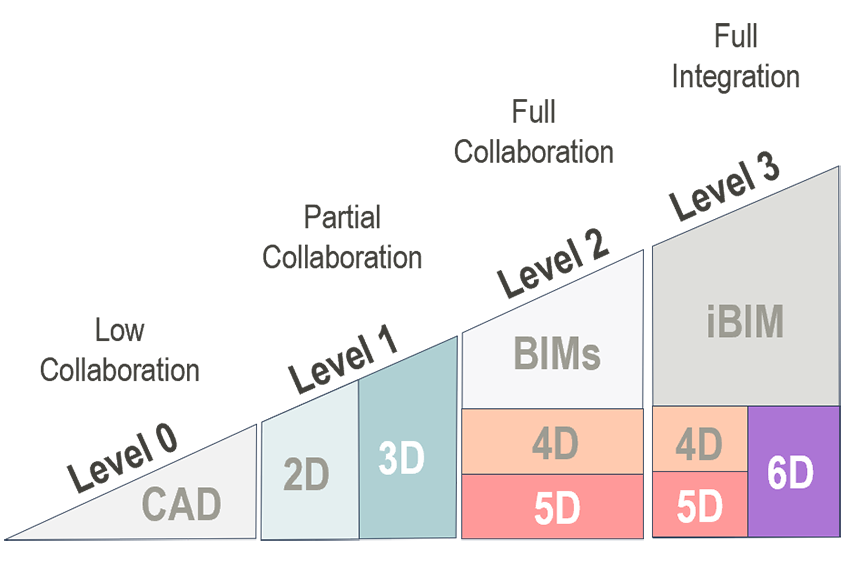
Figure 4.3.2.1 Maturity levels of BIM and BIM dimensions
Digital Twin
The term "digital twin" describes the "digital assets", i.e. the models or documents that represent a real, physical object throughout its lifecycle or at certain stages of its lifecycle. In the “BIM industry” (construction), a digital twin usually refers to a 3D geometric model of a building or bridge with all relevant attributes that represents and reacts to the real, physical twin, i.e., the real building or bridge, and may also generate certain reactions and changes in the real object. There can be a connection between the real twin and the digital twin. This connection can be either one-way or two-way (in both directions). Moreover, the connection can be either synchronous or asynchronous, depending on the so-called "coupling level".
CDE - Common Data Environment
The common data environment (CDE) is the central data repository required to perform the BIM Level 2 information sharing function. The CDE collects, manages and distributes relevant validated digital information about a built asset during the life cycle for multidisciplinary teams at the specified access level.
The CDE platform is generally hosted on an external server which is accessible to all parties involved in the in the design, construction and operation of the asset with the appropriate permissions. The CDE platforms have an automated information flow. Additionally, they use predefined ways of sharing, accepting and commenting digital information.
IFC - Industry Foundation Class
The Industry Foundation Class (IFC) is an open data format developed by buildingSMART for the information exchange and coordination between different process participants. The main advantage of such a format is its openness. Thus, it is possible to use it by software off different vendors (interoperability). IFC files contain all relevant object data such as geometry, location in space, individual elements data, element attributes.
buildingSMART
buildingSMART is an international organization aiming to promote the exchange of interoperable, open and non-proprietary data between software applications used within the construction industry. buildingSMART is involved in the development of IFC.
Level Of Detail
The level of detail (LOD) refers to the geometric content of the model and is used to define the required graphic content of the model at a particular stage of the project. As the project progresses, the components in the model will be delivered in more detail. For example, in the case of road design, one starts only with the gradient and the width of the road core to estimate the soil volumes. In the progress of the project, the cross slopes, geometry of the ditches and the layers of the road pavement are considered.
Level of Information
The level of information (LOI) determines the non-geometrical content of the model at certain stages of the asset. As the life of the asset progresses, the non-geometrical details increase. At the beginning, the pavement is represented as a purely geometric, spatial figure with individual pavement layers. As the project progresses, data on the individual layers is added, such as the construction material as well as detailed information on laboratory results. Later, in the operational phase, the bearing capacity of the overall structure and other condition data for the surface layer, such as skid resistance, are included.
Level of Model Definition
The level of model definition (LOMD) is the combination of LOD and LOI and defines the details required in a model at different stages of the project, both graphical and non-graphical. The client (owner, employer, customer) determines the level of detail required and documents it in the Exchange Information Requirements (EIR).
Despite the high level of awareness and acceptance of BIM applications in the construction industry, there is a conviction that the potential of BIM is not being sufficiently exploited. 64% of respondents who were asked about the biggest obstacles to the use of BIM give in the first place the lack of requirements by the client (NBS, 2019). This lack of requirements by clients for the implementation of BIM is particularly noticeable in infrastructure investments, including road construction.
The one-sided focus of BIM on planning and construction and at the same time the neglect of operations is one of the greatest weaknesses of the current orientation of BIM. This is also one of the reasons why BIM is so weakly spread among the owners and operators of horizontal infrastructure. This weak support for the operational phase and the network-orientation overlooks that investment costs during operation phase of the lifecycle represent 90% of total life cycle costs, while design and planning costs amount to only 1% (see Figure 4.3.3.1 - based on (NZ-BIM, 2019).

Figure 4.3.3.1 Infrastructure lifecycle phases and cumulative costs (based on (NZ-BIM, 2019))
The relationships between life cycle costs during the delivery and operational phases may differ from those stated above in the case of other asset classes.
With the support from the British government in the 1990s BIM solutions were developed including a landmark standard that was issued as UK: BS 1192:2007 (Collaborative production of architectural, engineering and construction information - code of practice) (BS 2007). This standard regulated the general principles of information management in the construction sector.
In the year 2018 ISO decided to adapt two British standards, which have become widely used worldwide: BS 1192-1 (concepts and principles) and PAS 1192-2 (delivery phase of assets). In addition, two other British standards PAS 1192-3 (operational phase of assets) and PAS 1192-5 (data security) have been incorporated into ISO international codes.
The international series of standards ISO 19650 already defines its field of action as information management in its title. It also considers information management as a "derivative" of Asset Management (ISO 55000) and organizational quality management (ISO 9001). These connections are shown in simplified form in Figure 4.3.3.2.
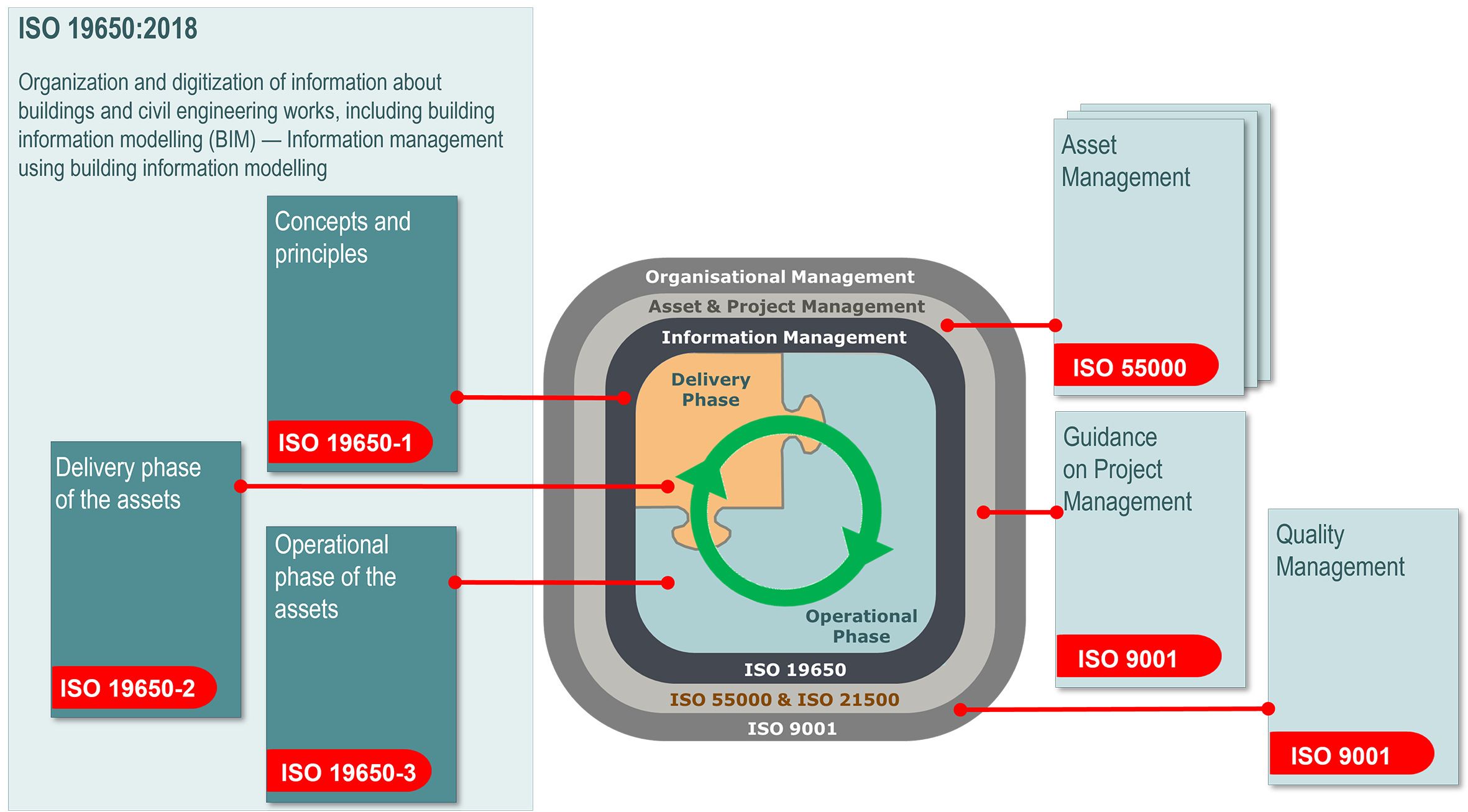
Figure 4.3.3.2 BIM-Standards and the Environment of other management norms
The ISO 19650 series of BIM standards are written in very general terms and do focus on specifics of BIM as solutions always depend on the context of the particular organization. However, through the reference in ISO 19650 to the Asset Management (as defined in ISO 55000), it is possible to derive the practical solutions and to implement the appropriate procedures.
The basic principles linking BIM with transportation asset management are outlined in the following paragraphs.
Orientation towards the relevant international standards
To promote sustainable solutions, the international standards are strictly referred to, especially the series of ISO 19650 norms as well as ISO 55000 (Asset Management). Where other relevant international standards are not available, reference is made to other recognized British standards, e.g. BS 8536 (GSL - Government Soft Landings) (UK BIM Framework).
Perspective of the specific organization
A fundamental role in BIM is played by the organization, i.e. the respective road administration (e.g. central or local road administration, municipal administration, etc.). All processes are developed and implemented from the perspective of the organization, its objectives and considering the unique organizational context. Thus, the interests of the owner, operator, or concessionaire are always at the forefront.
Compatibility with Asset Management
Asset Management, with its focus on the particular organization and its objectives, and on the entire road network or in many cases the whole asset portfolio, is the cornerstone of BIM in the road administration.
Special features of BIM for horizontal infrastructure
In order for BIM to be more widely used for horizontal infrastructure, BIM should take the owner's perspective and view the entire asset system as an asset portfolio, as required by asset management in accordance with ISO 55000.
BIM defines two main phases in the life of any technical object: the delivery phase and the operation phase. The delivery phase includes planning, designing, construction of the new object, but also all other building activities in the lifecycle, such as maintenance and rehabilitation. The activities in the delivery phase are usually performed by appointed contractor(s). The delivery and operational phases interrelated in that an asset is design and commissioned, it then goes through a phase of maintenance and rehabilitation and at this end of its functional life, it may be reconstructed, then repeating the maintenance and rehabilitation.
BIM supports the road asset manager by providing the information models for both lifecycle phases, namely Project Information Model (PIM) for the delivery phase followed by Asset Information Model (AIM) for the operational phase (see Figure 4.3.4.1).
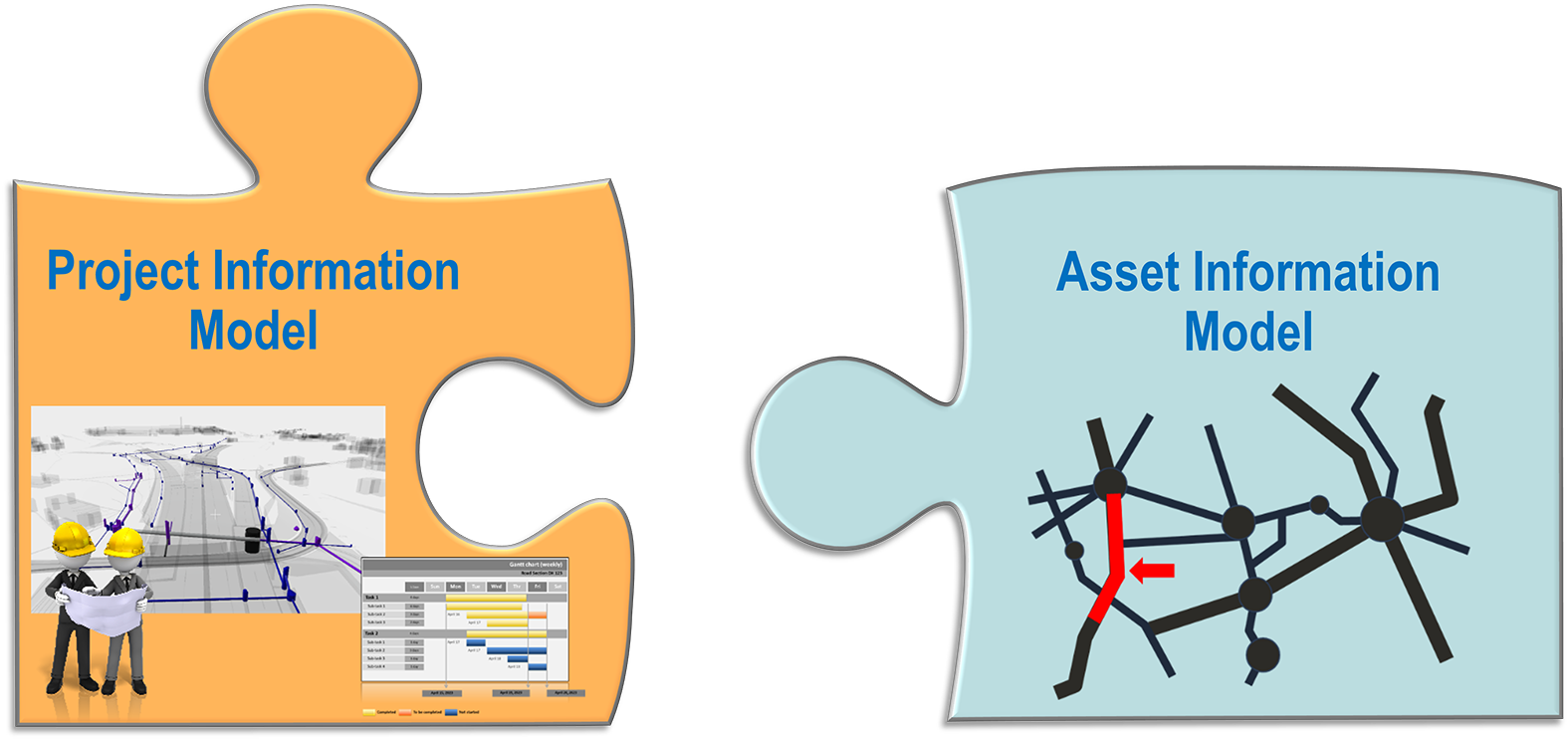
Figure 4.3.4.1 Interconnection between the network-oriented Asset Information Model and the measures-oriented Project Information Model
BIM according to ISO 19650 formulates uniform requirements for the information that is generated and managed in both lifecycle phases. These requirements are collected in a set of documents that support the asset manager (owner and operator) throughout the entire process of Asset Management. The two kinds of Information Models (AIM and PIM) and the documents containing the information requirements are the crucial pillars of BIM in the organization.
Figure 4.3.4.2 schematically shows the two main phases in the asset lifecycle with the corresponding information models and the most relevant trigger events (from "A" to "E").

Figure 4.3.4.2 Control loop of information and the relevant phases of the life cycle (based on ISO 19650-2 and ISO 19650-3 (ISO 2018))
The Asset Information Model covers the entire road network or asset portfolio under the jurisdiction of the respective road administration. The road database manages data and information to support ongoing operations as well as the planning of construction activities. As a rule, the road network model, the axis geometry, the cross-section elements, construction data, maintenance history, road equipment data, traffic data and, depending on their availability, other data such as bridges and tunnels, pavement and bridge condition data, images, accident reporting information, etc. are managed in this database. In addition to the standardized information in the road database, the Asset Information Model also includes other information, sometimes in distributed data sets or as "data containers" that may be integrated into decision-making processes as required.
The relevant tasks of the operator include the planning of routine operations (summer and winter operations) as well as planning construction and maintenance activities supported by Pavement Management Systems or network resilience analysis. The reporting on the inventory and condition of the entire network as well as the provision of relevant KPIs and other information for the owner and the general public are also based on the data from the Asset Information Model (see item "A" in Figure 4.3.4.2). These activities address the entire road network managed by the operator.
For pragmatic reasons, the Asset Information Model will not address the requirements for geometric accuracy (LOD) that are common in the planning and construction phases. In the operational phase, a focus on high LOD would be counterproductive because 3D models as applied to the delivery phase do not add value for many use cases, such as winter maintenance planning or prioritization of road sections for maintenance. The ISO 19650 standard emphasizes at several places that the Level of Model Definition (LOMD) must always correspond to the actual tasks and practical requirements.
Planning of maintenance and rehabilitation activities are regularly performed on the entire road network. It is in the operator's best interest that the changes of the as-built data resulting from the construction work are reflected in the Asset Information Model. One of the prerequisites for correctly updating the Asset Information Model partly already during or at the latest directly after the execution of the construction measure is providing the contractor with the current inventory data for the particular network element from the AIM (see item "B" in Figure 4.3.4.2).
Information management during the execution of construction activities is supported by the requirements outlined in the EIR (Exchange Information Requirements) and in the BIP (BIM Implementation Plan). The plan defines how the exchange of information between all parties will take place and how Common Data Environment will be developed.
The Project Information Model defined for the duration of the project determines both the data model (the digital twin of the construction object) and all data management processes. Effective information management and the exchange of information must be ensured (see item "C" in Figure 4.3.4.2). For larger projects with high realization costs and involvement of multiple parties, complex 3D data models will be applied. However, for small-scale projects, simple models are usually adequate.
Once construction activities are completed, the information is transferred from the Project Information Model to the Asset Information Model (see item "D" in Figure 4.3.4.2). The transfer is done in accordance with the requirements that are formulated in advance, during the needs assessment and documented as the Asset Information Requirements (AIR). Regardless of the scope and complexity of the specific project, it is relevant that all information about the completed project is coded according to the Asset Information Model standard. The information is transmitted either through the interface provided by the operator or through reconciled data services and controlled by the operator before the final update of the AIM (see item "E" in Figure 4.3.4.2). If the project has been implemented according to the highest level of BIM, it is recommended that the operator deliver the complete model (e.g. as an IFC model) in a data container and additionally extracts the data required by AIR from the PIM in the desired convention.
If all construction projects were performed according to the above-mentioned BIM requirements, a systematic update of the AIM and an increase in efficiency in the operational phase is achieved.
The construction projects carried out in the BIM standard differ from the traditional projects in that there are always two separate deliverables: one for the physical object, such as a modernized bridge or a renewed pavement, and the second proving standardized information describing these objects.
This second deliverable is the subject of modeling and should be provided according to specified rules in order to meet the objectives of the agency or operator. The complexity of the information should correspond to the scale of the particular project and reflect the strategic asset management objectives of the specific organization. To support the asset manager in formulating the information requirements ISO 19650 recommends that these requirements be grouped into a series of separate but linked, partially hierarchical documents.
ISO 19650 does not provide a blueprint for all these documents because they must always be consistent with the context of particular organization and should consider it size, maturity level and the need for the specific service.
Five most relevant BIM documents (see Figure 4.3.5.1) with information requirements have been briefly described below.
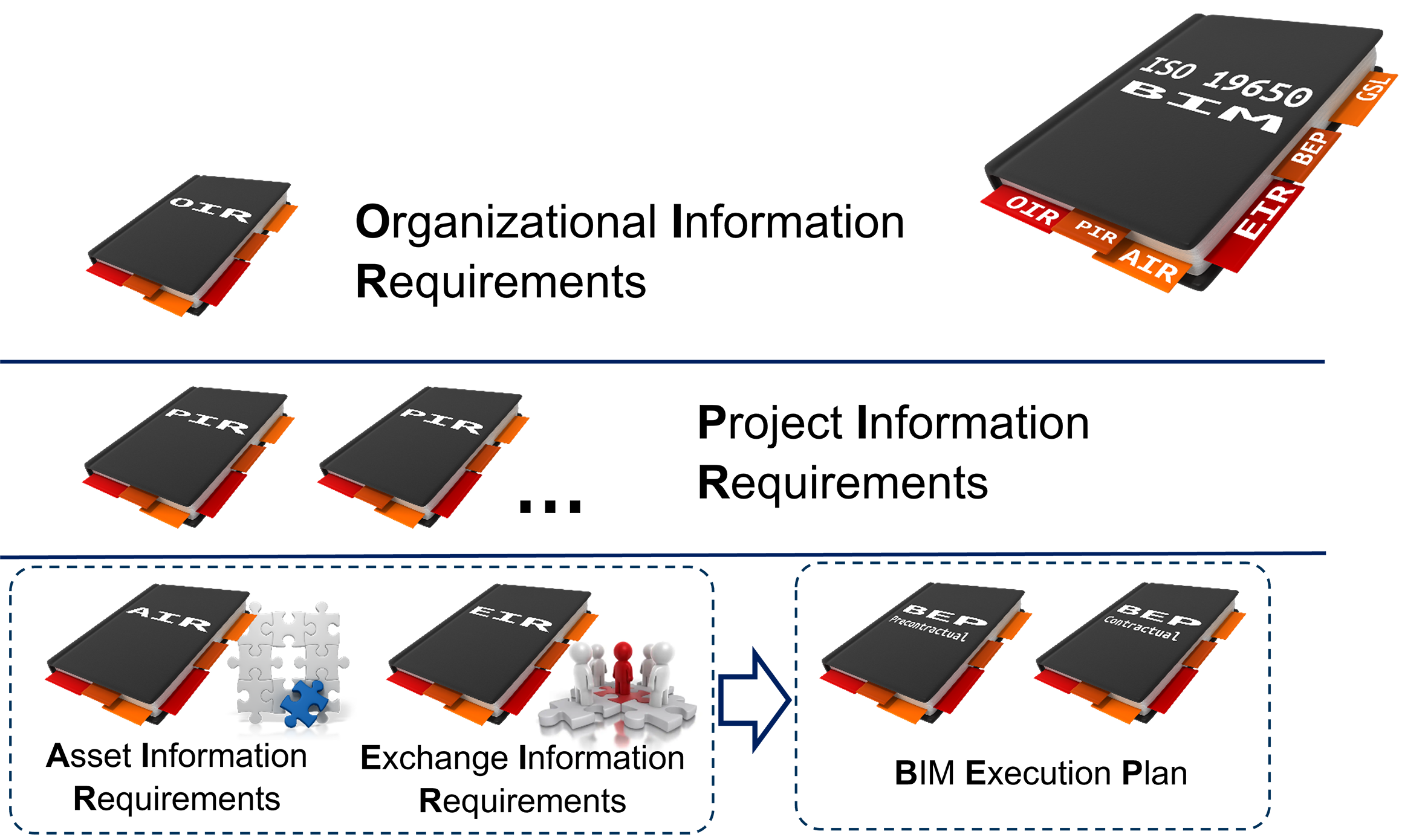
Figure 4.3.5.1 Most relevant documents for the information management in the organization
The most important document is called Organizational Information Requirements (OIR) and formulates the requirements resulting from the strategic goals of the organization and from the Asset Management System. The precondition for specifying these requirements is the identification of tasks to be performed by the relevant organizational units. In order to fulfil these tasks, information of a certain, task-specific quality is required, i.e. of a specific accuracy, completeness, timeliness, etc.
Each organization needs information for strategic tasks for the financial planning of investments (i.e. annual or multi-annual construction program) and for operational obligations. Some information also needs to be shared with external stakeholders, such as the local governments, the public, financial institutions and insurance companies. The detailed information regarding the asset construction measures assists in documenting the suitability of the construction materials and technologies, provides the basis for the pavement quality and for the development of prediction models. The general rules for determining the requirements for the information collected and managed, for its quality, level of detail, reference systems, etc. are the content of the OIR.
In modern road administrations, ensuring the flow of information in the required quality is as important as ensuring the availability of material and financial resources. Therefore, the necessary processes must be defined and procedures (such as regular pavement condition surveys) or tools (such as a road database) must be provided.
The Organizational Information Requirements establishes framework that apply to all other types of information requirements and are considered critical for BIM in an organization.
All transportation assets will require maintenance and rehabilitation measures to maintain the desired level of service. These projects are always associated with information that is collected, exchanged, transferred, updated, assessed, evaluated, etc. ISO 19650 recommends that the general requirements for information generated in connection with the realization of the projects of certain types are well documented in the Project Information Requirements (PIR).
Both documents, OIR and PIR, are internal documents of the organization. As OIR affects the work of all administrative units, it must be disseminated throughout the organization. Personnel responsible for tendering and supervising projects must be aware of PIR.
Asset Information Requirements (AIR) contain the OIR-derived requirements relate to the operational phase of the asset and are directed to the service providers, i.e., primarily the companies contracted to design and implement the construction projects. In the control loop of the information flow between the two phases shown in Figure 5, the transfer of information from the PIM to the AIM after project completion plays a fundamental role (see item "D" in Figure 4.3.4.2). Typically, this is the place/time where most of the information losses occur. Therefore, appropriate requirements for the information content, the process of information exchange and even the responsibilities and qualifications of the groups involved in this process must be formulated already in the phase or requirement setting.
AIR are closely related to the Government Soft Landings (GSL), which plays an important role in the "smooth" transition from the delivery phase to the operation phase. In order to ensure a GSL after completion of the construction project, a separate guideline has been issued.
Unlike the Asset Information Requirements, which refer to the phase of operation after the completion of the project, the requirements in the Exchange Information Requirements (EIR) are oriented to the delivery phase of a specific project. The document contains requirements necessary for an efficient exchange of information between the parties involved in the project in order to provide the contracting authority with answers to its business questions related to the procured investment project.
To ensure the required efficiency and quality of information exchange, EIR may require certain types of modeling of the assets involved and may also prescribe the procedures and tools to be employed. For example, modeling may be required to be performed according to specific LOD.
The two last documents - AIR and EIR - refer to the specific project and will be published during the tendering process.
Based on the EIR and AIR documents, the tenderer is requested to submit a BIM - Implementation Plan (BIP). The BIM Implementation Plan is the basic BIM document during the construction process. It describes the proposed manner of implementing the requirements formulated in the EIR and AIR and specified the details of the Common Data Environment (CDE).
Depending on the modalities of the tender, there can be two BEP versions: a pre-contractual version (offered BEP) and a contractual BEP.
Structured information management assists the asset manager to optimize the overall asset management goals. The ISO 19650 standards, by positioning BIM in a direct environment of Asset Management and by showing the mutual relations, have given considerable impetus and incentive for the adoption of asset management systems by the road infrastructure owner and operator. Figure 4.3.6.1 shows the relationship between the information generated through the asset management system and BIM, how they are generated, and how they are connected (Miskimmin).
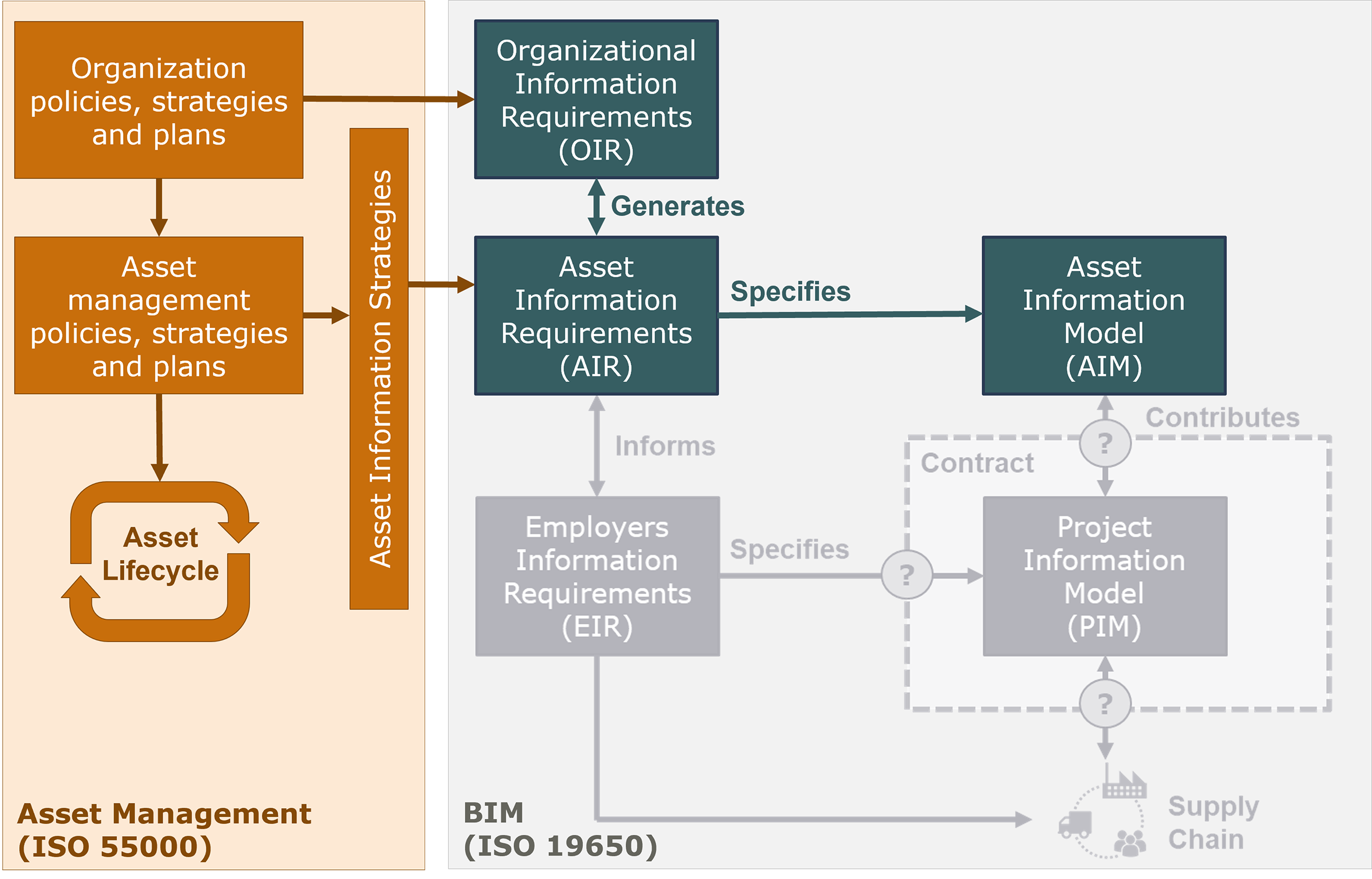
Figure 4.3.6.1 Relationship between Information generated in Asset Management and BIM (on the basis of Miskimmin)
It is certain that BIM will continue to be one of the most dynamically developing disciplines. This is definitely true for the technical BIM-solutions and hopefully also for the management solutions in the organizational environment of Asset Management.
BIM for all phases of lifecycle
Although the BIM methodology requires that the entire lifecycle of a given asset must be considered, the overwhelming majority of practical applications of BIM are still limited to design and construction. While for most building construction objects such an approach may be justified and rational, the asset manager of horizontal infrastructure, such roads, when planning the new construction, upgrading or renewal of a road, usually has to consider the subsequent actions within a road section, i.e. the repair or renewal actions resulting from the scenario provided by the Pavement Management System. Thus, this 4th dimension of BIM, that is time, is of particular importance for road infrastructure and should be extended to the whole life of the road section.
BIM for entire Asset Portfolio
The specific nature of transportation investments puts an additional, very important requirement on BIM. The coordination of construction plans by managers of different infrastructure systems responsible for the entire infrastructure portfolio is necessary, but this is a major challenge due to the frequent lack of organizational structures dedicated to the coordination of such tasks. The need to consider the entire infrastructure portfolio does not mean that every BIM project is burdened with further constraints and restrictions. However, the infrastructure manager must be aware of these realities and take them into account both in the formulation of the Asset Management Strategy by itself and in the requirements for individual BIM projects.
Continuing education of BIM professionals
One of the challenges in implementing BIM in the road sector is overcoming barriers and the lack of awareness among managers in road administrations regarding the benefits that targeted application of the discipline's methods will bring to them. This is confirmed by numerous surveys and polls. Considering BIM only as a tool for 3D modeling that supports the designer makes it very difficult to promote BIM as a management method.
Therefore, educational activities to disseminate and promote BIM and to raise awareness of its importance in the context of information management will play an increasingly important role. The broader the knowledge of the possibilities of BIM applications according to ISO 19650 among asset managers, the greater likelihood that managers will demand the development and implementation of BIM procedures.
Over time, two BIM streams have emerged. One stream is oriented towards optimizing the planning and construction phase of individual projects. The principle of this stream is: first build digitally and only then build for real. The addressees are the planning and construction companies. This BIM stream is mostly associated with 3D modeling.
The second BIM stream is oriented towards the entire road network and the primary addressees are the owners and operators of the infrastructure. The mission is to support broad digitalization in order to optimize the main objectives of the infrastructure owner. So, the message is addressed to the owner and operator and reads: keep control over your network data to optimize your goals. The main reference source of this second BIM stream is ISO 19650.
The appropriate implementation of BIM by the operator for all construction activities can lead to a breakthrough in digitalization in the road construction sector. The implementation of BIM in the road administration of the operators will also contribute to a better use of the information already managed in road databases. The simple existence of information and its availability is not enough. Only the transformation of information into knowledge, by making it available to the stakeholders involved and by a targeted exchange between all parties involved in engineering activities and decision-making processes, gives this information a real, tangible value. The result will be an increase in the quality and efficiency of the work, an increase in the agency’s rank and reputation, and an increase in the satisfaction of its employees.
In this chapter practical examples from Germany are used to show how the procedures of BIM according to ISO 19650 are applied for the systematic acquisition and provision of pavement condition data.
The ISO 19650 standard is written in a very general and partly abstract way. This is to ensure that the rules and best practices for information management can be applied as widely as possible. For practical application, however, adaptation to the specific features of the respective type of infrastructure is essential. Only then could practical benefits be derived from the application of the standard. Such adaptations and "translations" of the general rules, which are often formulated abstractly in the standard, into the "language" of the respective professional discipline are necessary in order to exploit the benefits of the ISO 19650 standard for the respective professional discipline.
At this point, it is important to emphasize that BIM, as interpreted by the ISO 19650 standard, is primarily focused on the acquisition and exchange of information relating to construction objects. Professional aspects such as design techniques or construction technologies are of course always important, but only to describe the general framework within which information management is performed. Furthermore, it must be clearly stressed that information management (like any management) is always situated in an organizational context. The goals of the respective organization, in this case the owner or operator of the road infrastructure, and the strategies and tasks derived from these goals determine the framework in which information management is practiced. For this reason, this chapter always refers to the respective general framework that determines the organization's actions, i.e., the organizational or professional context. This is to show that different solutions may be optimal in different circumstances.
In all construction activities, on the one hand physical objects are created or changed (e.g., structures are modernized) and, on the other hand, information is generated and exchanged that is necessary for the target-oriented execution of these construction activities. This information is essential for the operator, both during the construction phase and especially after commissioning of the completed construction object.
While the requirements for the technical tasks are formulated in the relevant professional standards, the BIM standard ISO 19650 formulates requirements for information management to achieve the goals of the construction project and to support its subsequent operation. The application of ISO 19650 is particularly useful in the case of multiple project participants. Experience shows that good information management has a positive effect on the efficiency of the actual project activities on the one hand, and on the other hand enables a smooth transition from the project phase to the operational phase after completion of the construction work.
Projects in which information management plays a key role include projects for the network-wide monitoring and evaluation, such as pavement condition data. Therefore, the execution of the projects for the pavement condition acquisition in accordance with ISO 19650 provides many benefits.
The German System for the monitoring and assessment of pavement condition ZEB (German abbreviation from Zustandserfassung und -bewertung) is based on the same established management rules as the British Standards series BS 1192:2007 (BS 2007). This standard was prepared with the aim of spreading digitalization to the entire construction industry. It was the first introduction of the then pioneering idea of a Common Data Environment (CDE). Since then, the CDE approach has been one of the most important features of all BIM-oriented construction projects.
Immediately after the publication of the British standard BS 1192, some of the ideas presented there were examined and validated in Germany with the aim of applying them in the framework of ZEB. In the same year of its publication (2007), the CDE concept was put into practice in a first pilot project for ZEB on state roads in Baden-Württemberg. Further BIM solutions were also successively adopted in the ZEB.
The most important principle of any information management in the organization is to acquire and manage data to the scope and quality required to support organizational goals. An abstract striving for the best quality of information without considering the current and planned scope of application contradicts not only the principles of modern Asset Management, but also elementary principles of economy.
When developing an information management strategy, it is therefore of fundamental importance to first identify the objectives and the resulting activities and tasks. Based on this, requirements must be defined for the information that contributes optimally to supporting these tasks and thus indirectly to achieving the company's goals (see Figure 4.3.7.3.1).
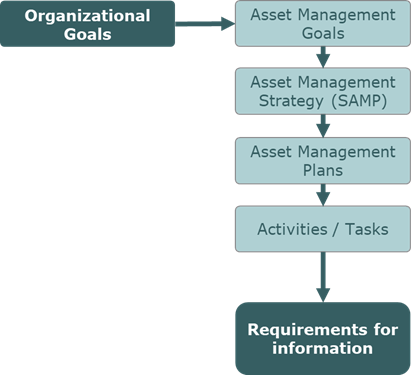
Figure 4.3.7.3.1 Requirements for the information are derived from the respective tasks
The organization's strategy for streamlined information management and the derivation of information requirements from the organization's goals, strategies, and plans are captured in the key BIM document, referred to in the ISO 19650 standard as Organizational Information Requirements (OIR).
Information about infrastructure represents a valuable asset and should be treated like other assets. The quality standard for the acquisition, evaluation and management of information should therefore be determined according to general economic principles. This involves comparing the benefits of using the information in the decision-making process with the costs of obtaining the information. The methodological basis for such consideration is provided by the discipline of Infonomics (Laney, 2017).
In this chapter, the terms "data" and "information" are often used interchangeably, although information management sees a clear difference. Data are the direct result of measurement or other survey and contain, for example, the elevation points of a roughness profile at 10cm intervals. They are often referred to as "raw data". By specific assessments, such raw data can be used to determine e.g. the IRI (International Roughness Index) for longer sections (e.g. of 100m), which are already considered as information, since these values can be used in decision-making processes. However, as long as the integration of the information into decision-making processes is hampered, e.g. because the access to the information is restricted or the form of presentation does not meet the expectations of the addressees, the benefit of such information is low or non-existent. Only when the information flows into decision-making processes and can have a positive impact on the goals of the organization will it reach the highest "evolutionary level", namely knowledge (see the so-called Knowledge Pyramid in Figure 4.3.7.3.2).
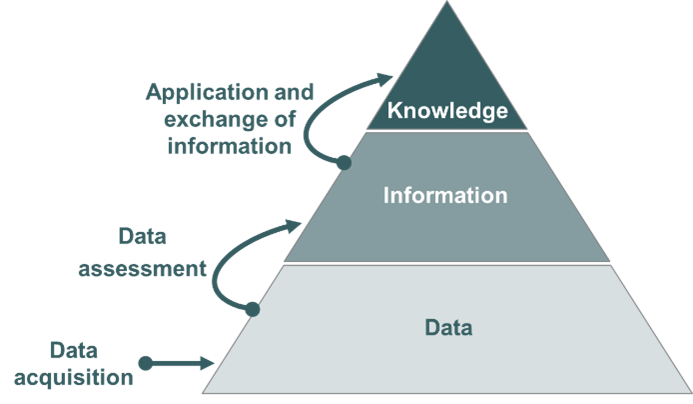
Figure 4.3.7.3.2 Knowledge Pyramid
For pragmatic reasons and also because of the technical terms already established in the road sector, the term "condition data" is usually used here, even when it is clearly "condition information".
Pavement condition data is used at all levels of Road Asset Management. Some selected applications of pavement condition data at the strategic, tactical, and operational management levels of road maintenance management are listed below.
Strategic management level:
• Determining medium and long-term maintenance needs in order to achieve specific quality objectives (measured by pavement condition),
• Ensuring horizontal (between sub-networks) and vertical (between sub-networks of different road classes) network consistency in the medium and long term, thus ensuring equivalent traffic performance in the overall network of the operators,
• Analyses of the performance (robustness) of construction technologies and materials based on the monitoring of the evolution of pavement conditions in the respective networks or sub-networks,
• Identification of Key Performance Indicators (KPI) for planning purposes and for the owner's bodies,
• …
Tactical management level:
• Allocation of maintenance funds to regional authorities to meet political and socio-economic demands and to achieve the desired level of disparity,
• Development of the short- and medium-term maintenance programs (localization of the maintenance measures) within the available budget,
• Controlling of the maintenance programs,
• …
Operational management level:
• Identification of the sources of damages,
• Determination of the appropriate type of measures for the planned maintenance programs,
• Early detection of unfavorable condition development,
• …
However, the pavement condition data is also used for numerous other tasks that go far beyond maintenance management. These include, for example, traffic safety analysis, including the calculation of safety potentials and support for safety audits. Geometry data, such as longitudinal slope and curvature, collected over a wide area during the pavement condition monitoring process are used for network-wide traffic engineering and economic analyses. In addition, route images routinely created during condition surveys are used for a variety of tasks, including for inventory purposes.
To ensure that the pavement condition data is suitable for the above-mentioned applications, it must permanently meet certain requirements.
The following three roles are always foreseen among the actors in the pavement condition monitoring and evaluation projects:
The most important requirements for the system for monitoring the pavement condition data include (Heller, 2011):
Standardization of data and processes
All processes of data monitoring and assessment must be kept stable over a longer period of time in order to ensure one of the most important requirements, namely the comparability of the condition data over time. This comparability over time is crucial, among other things, for the generation of prognosis models. At the same time, it must also be possible to compare the data between the administrations (between the sub-networks). Such spatial comparability is, in turn, a prerequisite for achieving the envisaged network consistency, which is an important strategic goal from the perspective of a road network owner's. Since pavement condition has a significant impact on driving comfort and safety, it is considered an important factor for this network consistency. In addition, the quality of the condition data must be ensured according to clear and standardized criteria in order to guarantee the comparability of the results of the pavement condition studies.
These requirements can only be met if the entire process for monitoring and assessment of the pavement condition data is standardized. In Germany, the ZTV-ZEB-StB (FGSV, 2006) represent such a standard.
Task-neutral monitoring and task-oriented assessment of pavement condition data
The ultimate result of the pavement condition monitoring is georeferenced raw data, so-called GEO raw data, in high resolution. They are delivered in files in defined and documented formats. Figure 4.3.7.5.1 shows a section of a GEO raw data file with longitudinal evenness data. The GEO raw data also includes the georeferenced route images as well as the high-resolution surface images, which provide the basis for the manual or automatic detection of surface properties in the later assessment phase.
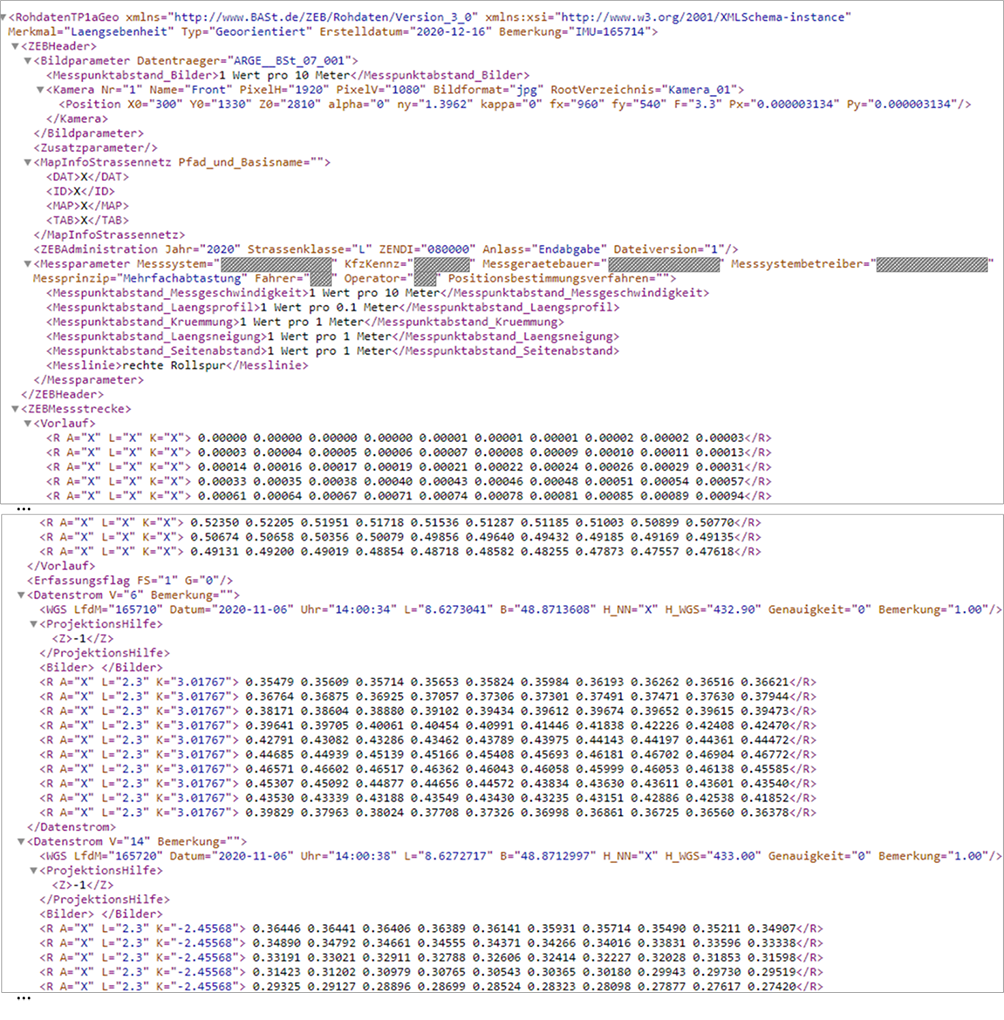
Figure 4.3.7.5.1 Fragment of a GEO raw data file with longitudinal evenness data
In GEO raw data, the entire data stream is typically referenced every 10 meters to a point whose location is uniquely determined by geographic coordinates.
For practical purposes, these GEO raw data must be assigned onto the network, i.e. onto the linear referencing system. Because the projection is done on the road axis and because of the inaccuracies in the recording of the coordinates, the raw data stream must be stretched or compressed accordingly. Since different methods can be used, the process of data projection is standardized and a freeware standard software (GEO-ROH-RASTER) is provided for these purposes by the federal authorities BASt (German Federal Highway Research Institute).
The GEO raw data projected onto the road network are aggregated in the data segments of an evaluation raster. One data segment of the raster corresponds to the ZEB evaluation sections of 100m in non-urban areas and 20m in urban crossings and is uniquely localized by means of the kilometers of the beginning and the end as well as by the indication of the traffic lane. All localization information must correspond to the current network model in the Asset Information Model (AIM).
The RASTER raw data generated in this way provided the basis for the computation of the pavement condition quantities and values, as well as for the visualization of the raw data, as shown on Figure 4.3.7.5.2.
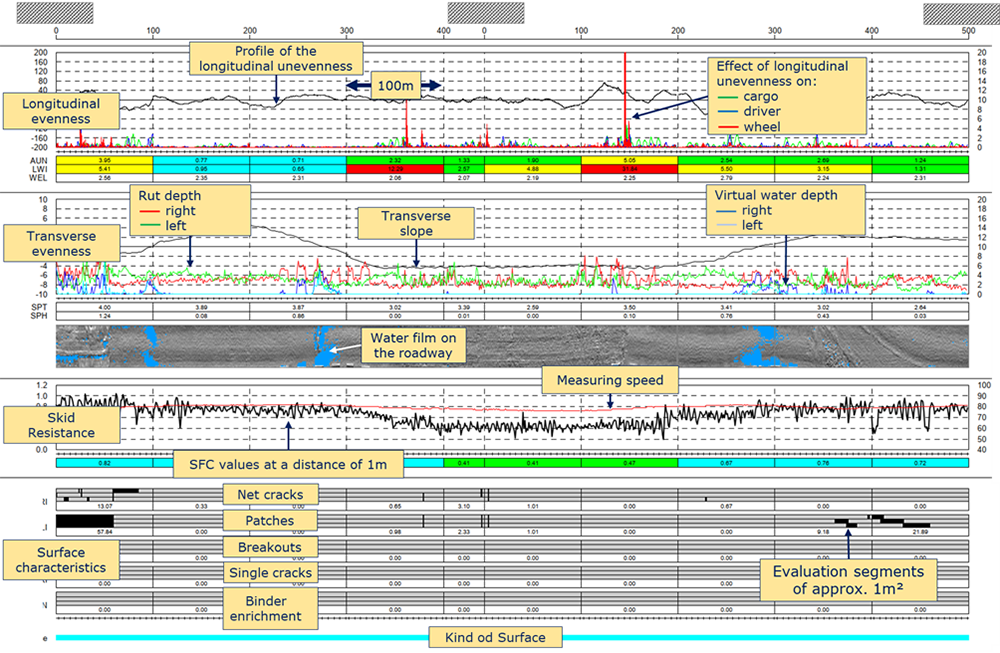
Figure 4.3.7.5.2 Example of a profile with RASTER raw data for the purposes of the operational tasks
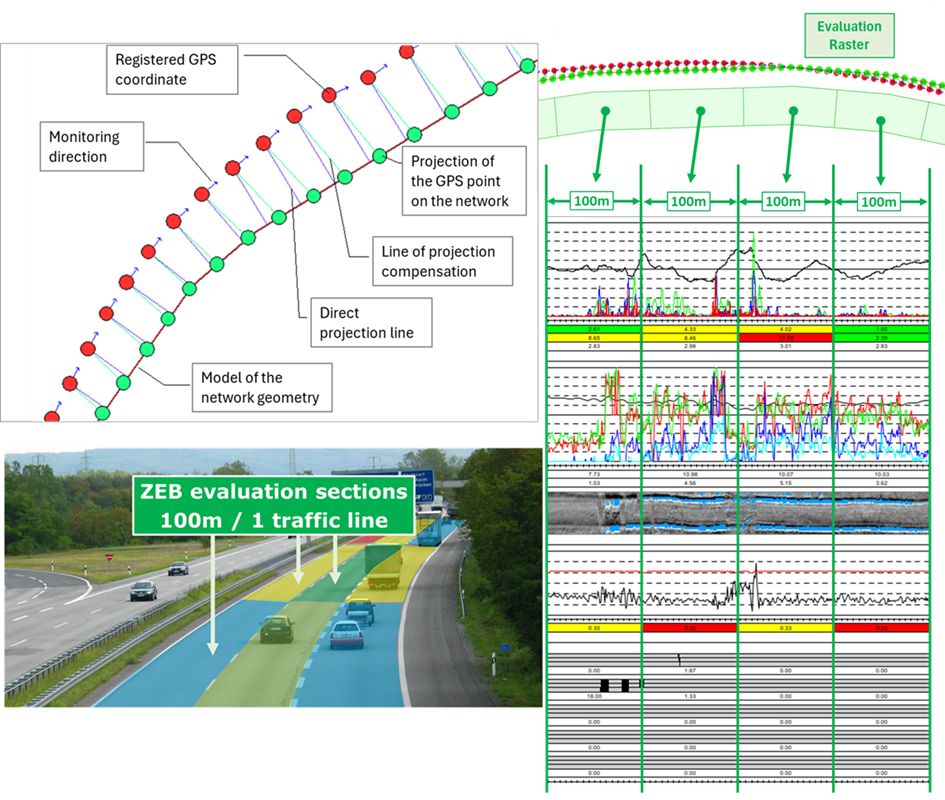
Figure 4.3.7.5.3 schematically illustrates the process of projecting GEO raw data onto the geometry model of the network to create the RASTER raw data.
The GEO raw data is the basis for further assessments:
Figure 4.3.7.5.4 shows the major standardized assessment steps of the pavement data.
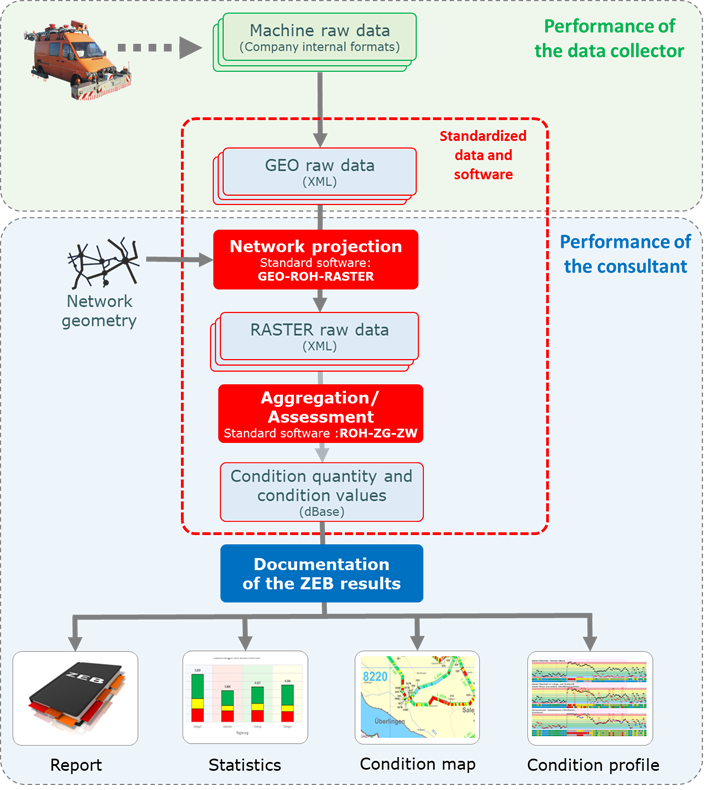
Figure 4.3.7.5.4 Standardized assessment steps of the pavement condition data
If, due to new research insights, the algorithms for determining the condition parameters change or new or alternative characteristics are defined, it is always possible to assess the historical GEO raw data from the previous ZEB projects according to the new algorithms and thus validate the object- and network-related consequences of such modifications.
The raw data also provide the basis for a wide range of applications, including those that were not known at the time of the survey. This high degree of flexibility is achieved by making the monitoring process somewhat 'task neutral', by giving the raw data the status of an ultimate data source and by standardizing its format.
In this way, the raw data can be used as a basis for further assessments that go over and above maintenance planning. For example, skid resistance data aggregated to 100m are of limited value for object-based analyses of traffic safety. Therefore, the indicators are calculated based on the moving average of 1-m measurement results, which are then linked to geometry data such as curvature. This allows areas with road safety gaps to be identified much more accurately and targeted.
In the meantime, there are also numerous other applications for the pavement condition data beyond road administration that benefit from the availability of the raw data, e.g. in the automotive industry. Even the route images recorded as part of ZEB, which were originally used only to check the plausibility of the condition data, are now being applied massively for various other purposes. The fact that these images are available network-wide in the same resolution and the required quality makes them a good basis for comprehensive photogrammetric assessments.
Efficient providing of the condition data and assessment results
As mentioned above, the real value of condition data and information is determined by their impact on specific decision-making processes . Providing the condition data in a suitable aggregation level and presenting or visualizing it in a suitable form are therefore of fundamental importance. As a result of ZEB, statistical assessments and visualizations in the form of diagrams, maps and profiles are thus provided in addition to the pure condition data (raw data, condition quantities and condition values as well as road or surface images). The raw data are also presented in a corresponding form on so-called raw data profiles (see Figure 4.3.7.5.2).
Since the spread of online technologies, it is expected that all relevant data and results are also available online for authorized users.
Sustainability
The described ZEB procedure was first introduced by the federal government in the early 1990s for the federal motorways. In the meantime, it is used by all German federal states and by many counties and cities. Even though the scope and procedure of the evaluation procedures are often adapted to the local circumstances in the individual federal states or counties, which is made possible by the principle of task-based assessment, the general approach of ZEB must remain unchanged over the years.
In order to ensure the long-term comparability of the results despite the shareholding of different actors, the BASt has commissioned the development of special software for all relevant evaluation steps, which is made available free of charge to all companies involved in ZEB projects. The software is continuously maintained and kept up to date.
All pavement condition data and information are affected by a life cycle. They are either in the phase of acquisition, i.e. monitoring and assessment within the framework of a ZEB project, or in the phase of utilization or application.
These two phases of the life cycle of the condition data are closely related to the life cycle of the road infrastructure. In accordance with the terminology of the ISO 19650 standard, the two phases mentioned above can be referred to as the delivery phase (providing the condition data for use in the operational phase) and the operational phase.
The data model of condition data at the delivery phase is called in ISO 19650 the Project Information Model (PIM). In the subsequent operational phase, the condition data are part of the digital model of the entire road infrastructure, i.e. the Asset Information Model (AIM).
Since the pavement condition changes continuously, the condition data must also be updated periodically (see Figure 4.3.7.6.1). The distinctive events (according to the ISO 19650 standard), such as the transition from the operational phase to the delivery phase (B), are also shown in this figure. The index indicates which ZEB project is concerned. The explanations of these distinctive events can be found in the further part of the present document.
As a rule, the ZEB project is repeated every 4 years. During the delivery phase (ZEB project), the current condition data from the road infrastructure Asset Information Model are still used. Directly after, the updated condition data is transferred to the Asset Information Model and the previous condition data is historicized for use in analyzing condition changes.
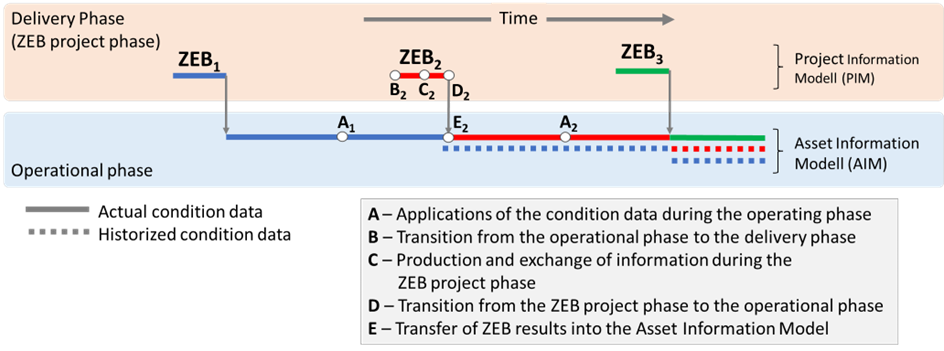
Figure 4.3.7.6.1 Life cycles of the pavement condition data (the distinctive events A-E are explained in Figure 4.3.7.6.2)
This permanent change between the phases of delivering and operating is represented in ISO 19650 as a control loop of information (see Figure 4.3.7.6.2). The distinctive events (based on ISO 2018) / activities (A to E) are described below.
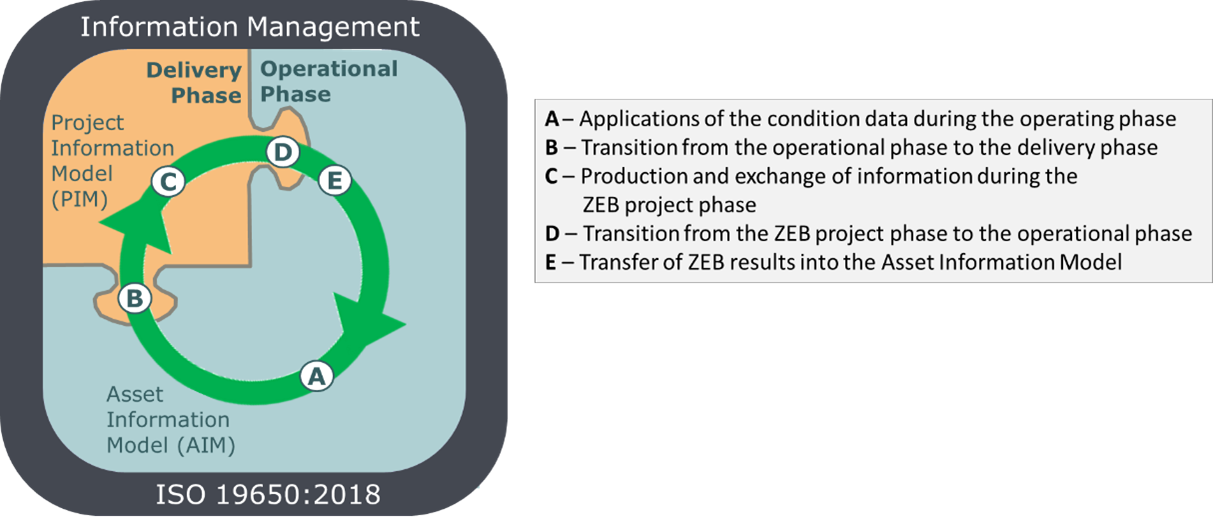
Figure 4.3.7.6.2 General representation of the control loop of information with distinctive events (based on ISO 2018)
A - Applications of the condition data during the operating phase
In the operational phase, the network-wide condition data are used for numerous tasks at all decision-making levels. Some examples of such tasks are given in Chapter 4.3.7.4. In most cases, the condition data integrated in the digital model of the network, i.e., the Asset Information Model (AIM), is used. However, some special applications require raw data or special indicators that are not available in the AIM. In such cases, appropriate professional systems are used.
B - Transition from the operational phase to the delivery phase
Event (trigger) "B" in the control loop of condition information refers to the initialization of a ZEB project. The client (usually the operator of the road network) formulates the requirements for the results of the pavement condition monitoring and assessment. These requirements cover the formats of the GEO raw data as well as the formats of the result files and the files with images. In ISO 19650, these requirements are referred to as Asset Information Requirements (AIR). Meeting these requirements ensures that updated condition data can be imported directly into the operator's Asset Information Model after finishing the ZEB project.
In addition, requirements are formulated for the entire monitoring process, for quality control, for data exchange between the actors, and for data provision, including deadlines for all milestones scheduled in the project. These requirements are referred to in ISO 19650 as Exchange Information Requirements (EIR).
Both groups of requirements, i.e. Asset Information Requirements and Exchange Information Requirements, are components of the tender documents.
Within the framework of a tendering procedure, the client selects one or more contractors to be commissioned with monitoring (data collector) and one consultant, who is independent of the data collectors. The consultant's tasks correspond to those of the BIM coordinator, but go beyond this and extend to professional activities.
One of the consultant's tasks is to set up and operate an IT system that serves as a Common Data Environment (CDE) on the one hand and is equipped with advanced modules for assessment and other analysis on the other. The general requirements for the functionality of the CDE in all phases of the ZEB project are formulated in the respective tender documents. They comply with ISO 19650's BIM Implementation Plan (BIP).
In addition to the classic tasks of a BIM coordinator, the consultant has to fulfill a number of professional tasks, which are particularly related to quality management. These tasks include, among others:
C - Production and exchange of information during the ZEB project phase
The ZEB project is characterized by a very high level of complexity. Large amounts of data and information are exchanged between the involved actors and along the interfaces between the realization phases. Any disturbances in this exchange of information at these interfaces would have a negative impact on the efficiency of the entire ZEB project and cause delays in the delivery of condition data, which in turn would have a negative impact on the routine tasks of the operators and owners.
For this reason, the client formulates strict requirements in the document - EIR (Exchange Information Requirements) for meeting the deadlines for the individual milestones and for the quality of the data and results. The three objectives are followed:
Although the ZEB projects have already been implemented for several years using the same procedures and one might think that they have therefore reached routine status, the complexity of the project and the numerous risks indicate that a high degree of flexibility is also required in the design of the entire approach.
The prerequisite for meeting these demanding requirements for ZEB projects is the support of professionally qualified staff that understands the requirements of the client and acts accordingly, as well as the implementation and operation of an IT system with the CDE functionality and with other features for solving specialized tasks. The Customer formulates the requirements for the functionality of such IT system that will be applied throughout the project phase.
The OnKo system is used as the CDE platform for the ZEB in almost all ZEB projects in Germany. Since its first deployment in 2007, the CDE/OnKo platform has been used in ZEB-projects in Germany and abroad, managing condition data on a coverage length of more than 700 thousand lane kilometers only on federal highways and state roads.
D - Transition from the ZEB project phase to the operational phase
The ZEB project ends with the handover of all contractually agreed delivery objects, i.e. the GEO raw data files, the RASTER raw data files, the results files, the files with route and surface images as well as the documentation and visualization of the results by the consultant to the client. The amount of data is considerable. For example, a ZEB project for state roads in Baden-Württemberg in 2020 generates more than 8 terabytes of data.
E - Transfer of ZEB results into the Asset Information Model
Most of the digital models of the road infrastructure (Asset Information Model) of the federal states in Germany are limited to the management of aggregated data, i.e. the condition quantities and values for the individual evaluation sections (100m/20m). Often the road images are also included. The raw data are usually not included in these models.
Deviating from such approach, some federal states, including Baden-Württemberg, have decided to use the CDE/OnKo - platform not only during the ZEB project, but also after its completion as a supplement to the digital model of the road infrastructure (Asset Information Model). So OnKo takes on another role, no longer as a CDE - platform, which it played during the ZEB project, but as a specialized system for the assessment and providing of pavement condition data.
The GEO raw data managed on the OnKo platform meet the requirement: "Single Source of Information" and thus, as a continuation of the CDE in the ZEB project, represent the original source for all pavement condition indicators generated from the GEO raw data, in particular condition quantity and condition values. OnKo is also equipped with a WFS (Web Feature Services) to integrate the condition data and images into third-party applications. The geographic layers with the condition classes can be integrated into external GIS applications using WMS (Web Map Services).
Furthermore, OnKo has the functionality to project condition data from previous ZEB projects onto the current road network and thus realize so-called dynamic data evaluations. Figure 4.3.7.6.3 shows an example of such an assessment of the dynamics of pavement condition.
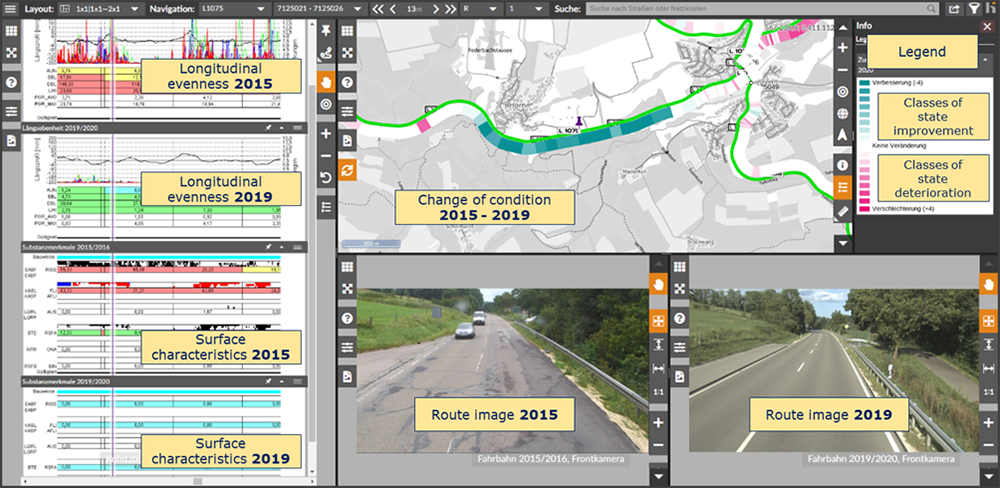
Figure 4.3.7.6.3 Example of professional analysis of pavement condition dynamics with OnKo-System (here: condition on a upgraded road section)
Although ZEB projects have been regularly performed in the area of federal trunk roads since 1992, and a few years later in the area of state roads as well, it took several years to establish a uniform IT solution to support these projects. This was triggered by the idea of a Common Data Environment presented in the British Standard BS 1192 in 2007. In the same year, the idea of a Common Data Environment as a platform for the exchange of information was realized using software within the framework of a ZEB project for the state roads in Baden-Württemberg and implemented throughout the entire network.
This data and information platform is used for the exchange of information and furthermore for the maintenance, quality control and assessment of the ZEB data in all its four "evolutionary stages": Work in Progress, Shared, Published and Archive (see Figure 4.3.7.7.1 (based on BS, 2007)).
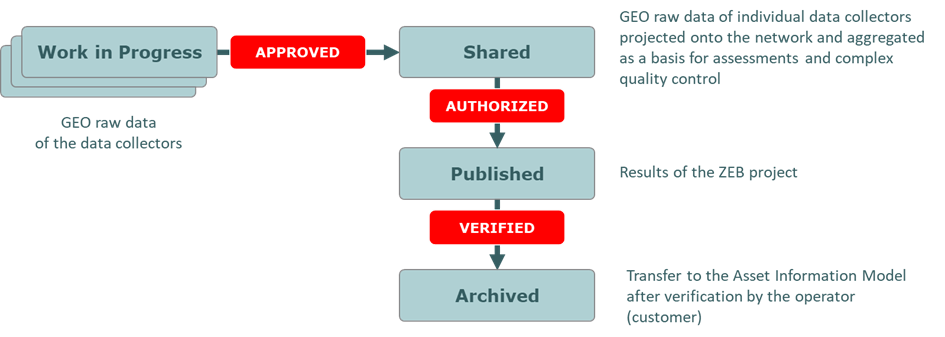
Figure 4.3.7.7.1 The "evolutionary stages" of information on CDE (based on (BS, 2007))
CDE/OnKo is also provided with functions for interactive and synchronized visualization of the pavement condition data. This enables the authorized stakeholders, especially the client and the consultant's team, to perform a complex control of the collected raw GEO data at the stage: Work in Progress and especially after their verification and aggregation at the stage Shared. For this purpose, a special visualization of both, the raw data and images was made available online, so that the client's on-site could also contribute to a better control of the data with their knowledge of the local circumstances. Their comments, especially the critical ones that could be entered online in fields provided for this purpose, contribute to the successive building of a knowledge base for the engineering assessment of the interpretation of the surface properties.
Currently, the CDE/OnKo platform is equipped with all the functions that support the consultant in all his specialized tasks, including the procedures for quality control and complex assessment and visualizations.
In the following, the main functions of the CDE/OnKo platform in the ZEB projects are listed.
Archive and knowledge base
On the CDE/OnKo platform, all relevant documents for the subject area of ZEB as well as for the respective ZEB project are made available. This includes, among others, tender documents, rules and regulations and other documents with the status archive.
Documentation of the recording scope
The client determines the scope of ZEB monitoring (so-called ZEB basic data) by specifying the location of the road sections and lanes to be monitored. Since the client may at any time specify deviating regulations or special treatment of individual route sections, his decisions will be communicated to the consultant and documented by him accordingly.
The information on the monitoring order is uploaded to the CDE/OnKo platform and is available for download by the data collectors in the form of lists of relevant route sections, maps and road profiles.
Ongoing control of the monitoring progress
The data collectors are obliged to report at specific time intervals, usually weekly, on which sections data were collected during this period and which parts of the network could not be surveyed for specific reasons (e.g. due to construction sites or other disruptions).
Such information about monitoring progress is stored on the CDE platform, automatically assessed and presented online for the customer in the form of maps and statistics. This type of progress monitoring is considered an essential element of risk management and fulfills the function of an "early warning system" for the case that the data collector's performance should be hindered.
Assessment of the control measurements
The client has the to let third parties perform the control measurements on certain routes of his choice. The decision on which routes the control measurements are to be performed is the sole responsibility of the client. Sections that have already been recorded as part of the regular monitoring, as can be seen from the monitoring progress, come into consideration.
The results of the regular monitoring and those of the control measurements are imported as GEO raw data into the CDE/OnKo platform and compared by the consultant on the basis of the criteria and tolerance values specified in the ZTV-ZEB-StB. Afterwards, the consultant creates the standardized check report. In case of deviations over the tolerance values, the client takes appropriate decisions to ensure the reliability of the ZEB results.
Data control on the intermediate deadlines and on the final deadline
The data collectors are obliged to transfer the recorded and quality-assured results of the condition monitoring as GEO raw data as well as files with images to the CDE/OnKo platform for the purpose of complex verification at specific deadlines. Alternatively, in the case of larger data volumes, the GEO raw data and in particular the image files can be transmitted to the consultant on a data storage medium and he then imports them onto the CDE/OnKo platform. The client usually orders one or two intermediate deadlines. These correspond, for example, to 20% and 60% of the planned scope of data capture. The interim deadline at the beginning of ZEB (20%) serves as a further element of the "early warning system" to identify risks to the ZEB project in time and minimize their consequences.
The data control includes 2 main steps: the technical and the functional control.
The technical control involves the automatic checking of the formal IT requirements for the formats of the files with GEO raw data and for their required contents. The route images and the surface images are also checked according to the predefined criteria. If the files do not meet the predefined control criteria, the data collectors are requested to correct them and deliver again.
After the positive outcome of the technical control, the prerequisites are given to perform an automatic assessment and to aggregate the GEO raw data to the longer evaluation sections. Subsequently, the raw data and the determined condition quantities and values are visualized for the purposes of the functional (specialist) control. The functional control to achieve the stage shared will be performed by the consultant's staff on the terminal equipment of the CDE/OnKo - platform. In addition, the client's staff has access to the visualization functions and, thanks to their local knowledge, can contribute to the control of the data and, above all, to the interpretation of the damage images. The functionality to visualize the condition data in the Share - stage also by third parties (not only by the consultant) for control purposes was already part of the functionality of the CDE/OnKo platform in the first year of the application (2007) (see Figure 4.3.7.7.2 and Figure 4.3.7.7.3).
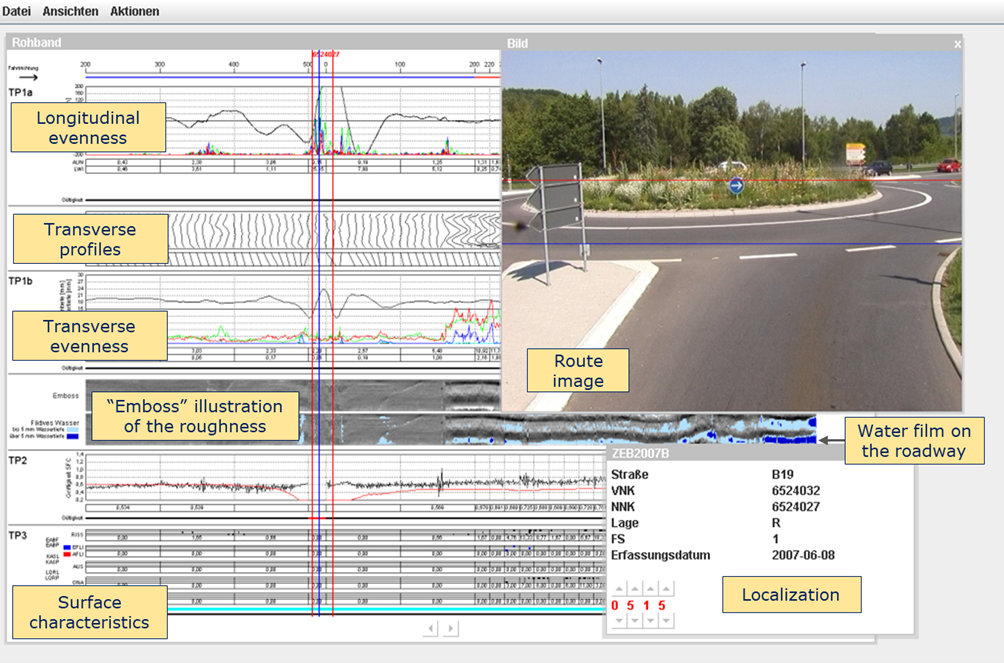
Figure 4.3.7.7.2 First CED/OnKo application in 2007 for state roads in Baden-Württemberg
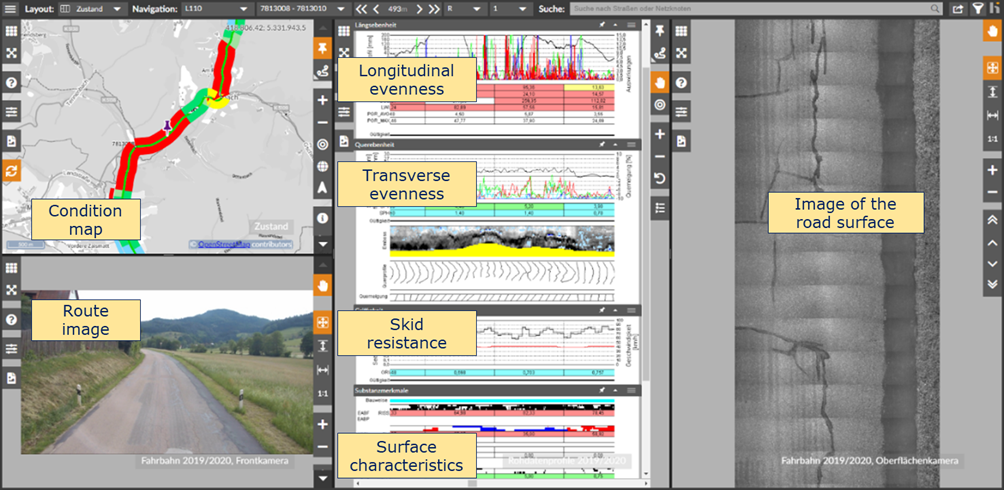
Figure 4.3.7.7.3 Examples of visual data control on the CDE/OnKo platform in 2020 for state roads in Baden-Württemberg
Assessment of pavement condition, statistical analysis and visualization
After the functional control of the data has been positively completed, the final assessment, statistical analysis and visualization of the data on maps and road profiles is performed (see the corresponding examples in Figure 4.3.7.7.4, Figure 4.3.7.7.5, Figure 4.3.7.7.6). The condition data then receive the status: published and can already be used for further, task-related assessments by the client (operator). The CDE/OnKo platform is equipped with all the necessary functions to realize these analytical assessments and visualizations automatically. The results are then made available in the required formats on the CDE/OnKo - platform for downloading by authorized parties, especially the operator's staff. The condition data in the Published status are considered as final results of the respective ZEB project.
The operator (client of the ZEB project) then decides which results of the entire ZEB project are transferred directly into the respective road information database (Asset Information Model) and are awarded the status archive. The verification of the ZEB results by the operator and their transfer into the Asset Information Model can be done outside the CDE/OnKo platform or by using the corresponding functionality of CDE/OnKo.
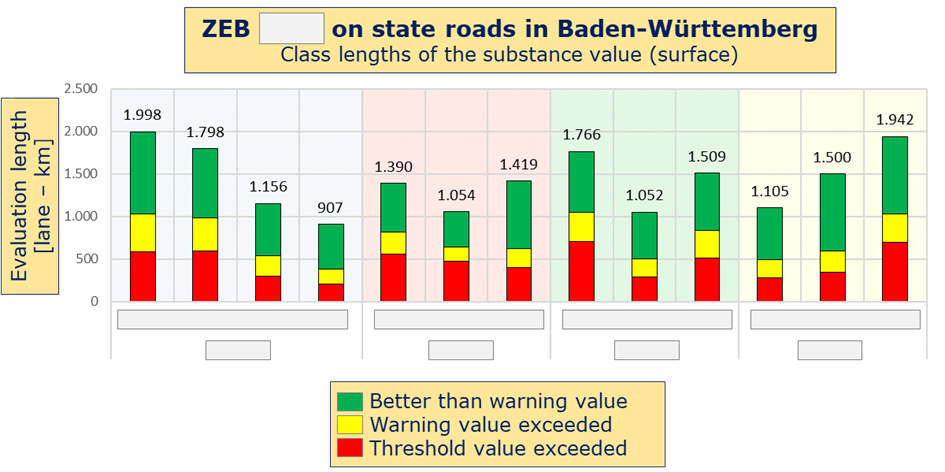
Figure 4.3.7.7.4 Example of statistical assessments
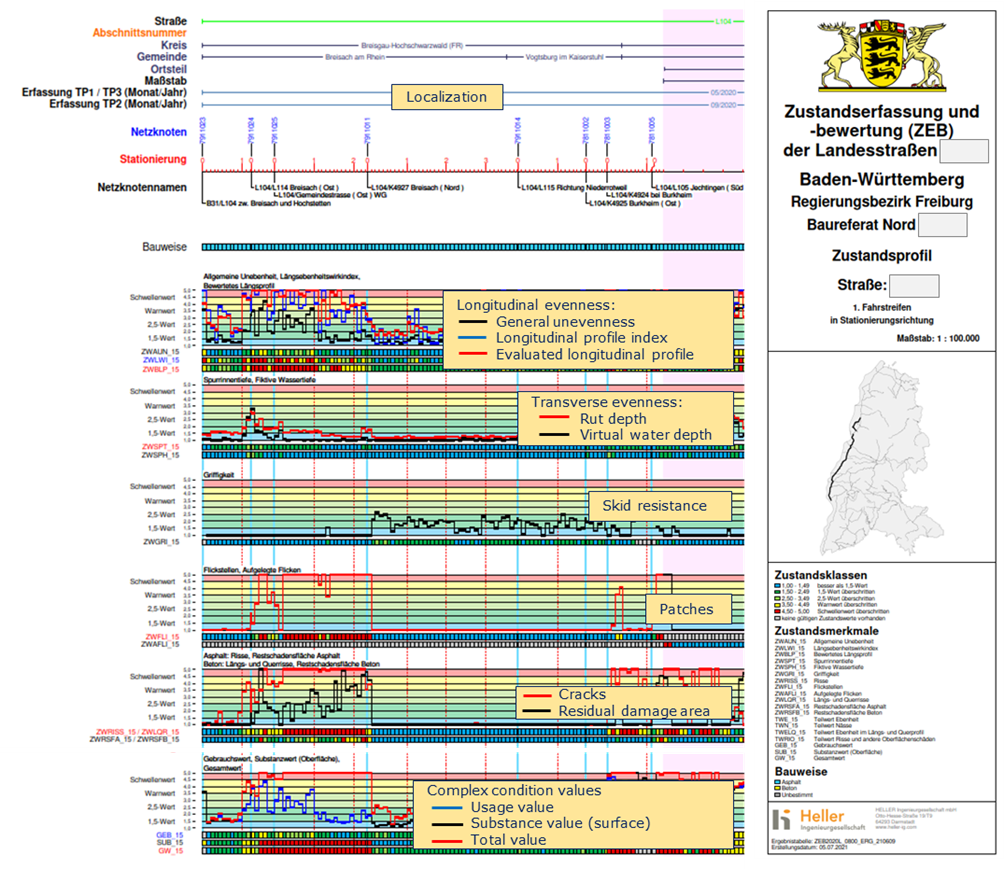
Figure 4.3.7.7.5 Example of a profile of condition values and condition classes
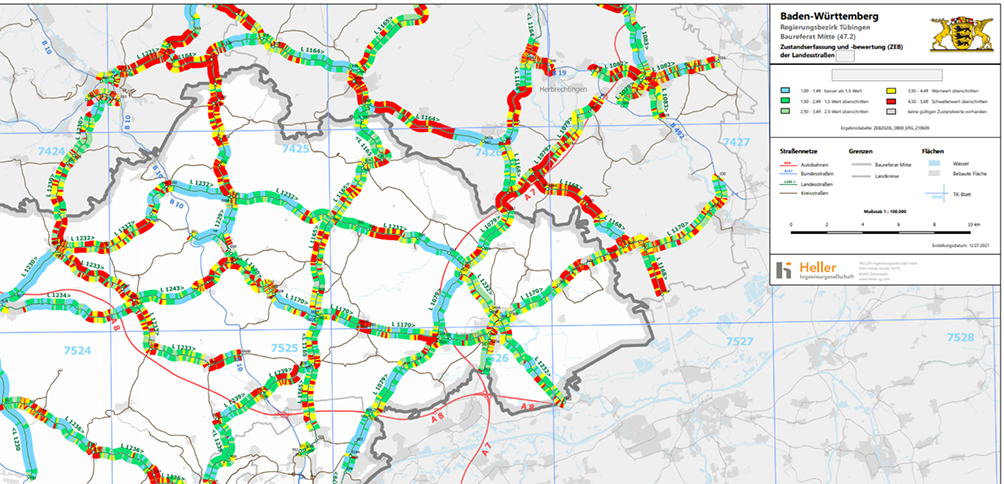
Figure 4.3.7.7.6 Example of a map with condition classes
The German ZEB is an example of the practical implementation of the general BIM approach described in the BS 1192:2007 and ISO 19650:2018 standards for monitoring and managing road infrastructure data. Both the general information management requirements formulated in these regulations (e.g., deriving the requirements for condition data from the organizational goals of the operator) and technical solutions (such as CDE) are used here.
This also follows an important principle of digitalization that is highlighted in several places in ISO 19650, namely an approach that is as broad as possible and not limited to large projects. It is namely expected that the solutions applied always correspond to the dimensions of the respective project. Considering this basic principle, scaling both the ZEB process and the data management requirements is not only possible, but necessary. Thus, the CDE/OnKo solution could be successfully applied for large projects on federal highways with over 30,000 lines-km as well as for small and micro projects on county, municipality or concession level with a length of a few hundred kilometers.
The high flexibility of the ZEB approach due to the central position of the GEO raw data and the simultaneously flexible and service-oriented architecture of the CDE/OnKo platform made it possible to implement this platform into the IT environment of the existing database systems of different operators after completion of the ZEB project. Thus, CDE/OnKo could be used as a platform for the intersection and visualization of condition data in the combination of inventory, traffic, measures and other data not only in Baden-Württemberg, but also by road infrastructure operators in other countries such as Austria (ASFINAG), Portugal (Infraestructuras de Portugal) or China (JSTI).
One of the principles of modern asset management is the need to continuously validate the technology and, above all, to verify that it is in line with the current objectives and strategies of the operator's organization. This, and also the need to reflect the current state of the art, results in the requirement to continuously improve the respective solution, even if it is working error-free at the moment. This is only possible in close and cooperative partnership with the client (operator), who is responsible for implementing the operating strategy.
PIARC, 2023."BIM and Digitalization", Technical Committee 3.3 Road Asset Management, WG 1 Innovative Approaches for Asset Management Systems. (https://www.piarc.org/ressources/publications/source/3/115863f4-44670-20...)
ISO 19650, 2018. Organization and digitization of information about buildings and civil engineering works, including building information modelling (BIM) - Information management using building information modelling.
ISO 55000, 2014. Asset Management - Overview, principles and terminology.
McKinsey, 2016. McKinsey Global Institute, Bridging Global Infrastructure Gaps, 06/2016.
NBS, 2021. BIM dimensions – 3D, 4D, 5D, 6D BIM explained. (https://www.thenbs.com/knowledge/bim-dimensions-3d-4d-5d-6d-bim-explained)
NBS, 2019. 9th Annual BIM Report (https://www.thenbs.com/knowledge/national-bim-report-2019#article-1).
NZ-BIM, 2019. The New Zealand BIM Handbook, A Guide to Enabling BIM on Built Assets, 2019 (https://www.biminnz.co.nz/s/NZ-BIM-Handbook-May-19.pdf).
BS 1192, 2007. Collaborative production of architectural, engineering and construction information - code of practice.
UK BIM Framework, 2019. Government Soft Landings. Revised guidance for the public sector on applying BS8536 parts 1 and 2. Updated for ISO 19650, 2019.
Miskimmin, 2017. Miskimmin, I.: Plain Language BIM, Bentley Institute Press, 2017.
Laney, 2017. Laney, D.B.: Infonomics: How to Monetize, Manage, and Measure Information as an Asset for Competitive Advantage, Gartner, Inc. 2017.
Heller, 2011. Heller, S.: Future developments in maintenance management and the monitoring and evaluation of pavement condition. In: Maintenance Management for Bavarian roads, Bauintern, special edition, 2011.
FGSV, 2006. FGSV: Zusätzliche Technische Vertragsbedingungen und Richtlinien zur Zustandserfassung und -bewertung von Straßen, Forschungsgesellschaft für Straßen und Verkehrswesen, 2006.